Marketing in Global Context
VerifiedAdded on 2023/06/13
|29
|6209
|197
AI Summary
This report provides an overview of marketing in the global context for Marks & Spencer that is seeking expansion into the international markets of Asia for its fashion-clothing brand post the Brexit. It includes SMART international marketing objectives, identification of market entry modes, potential segmentation, branding and positioning, and marketing mix decisions. The report is aimed at providing insights into the Asian market and how Marks & Spencer can gain a competitive advantage.
Contribute Materials
Your contribution can guide someone’s learning journey. Share your
documents today.
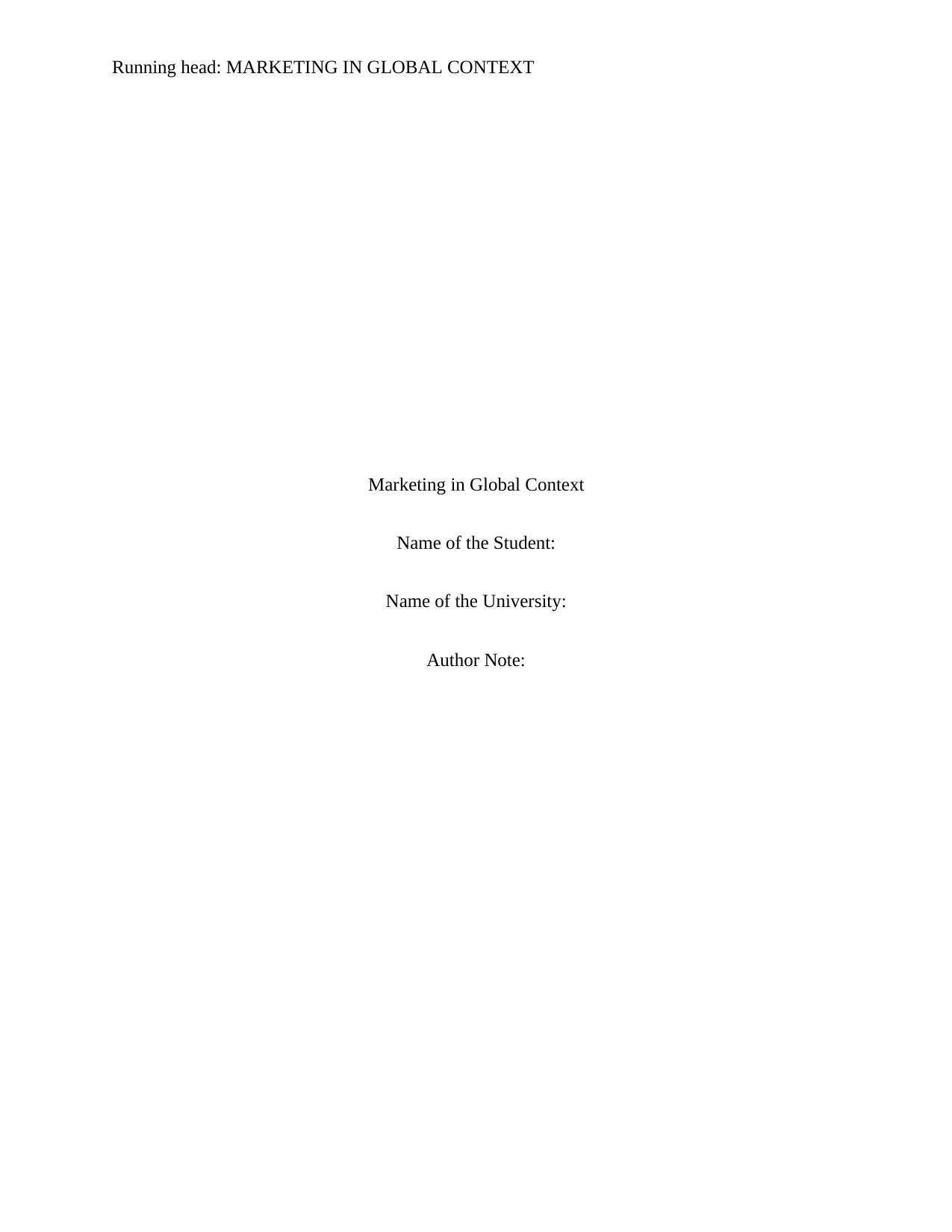
Running head: MARKETING IN GLOBAL CONTEXT
Marketing in Global Context
Name of the Student:
Name of the University:
Author Note:
Marketing in Global Context
Name of the Student:
Name of the University:
Author Note:
Secure Best Marks with AI Grader
Need help grading? Try our AI Grader for instant feedback on your assignments.
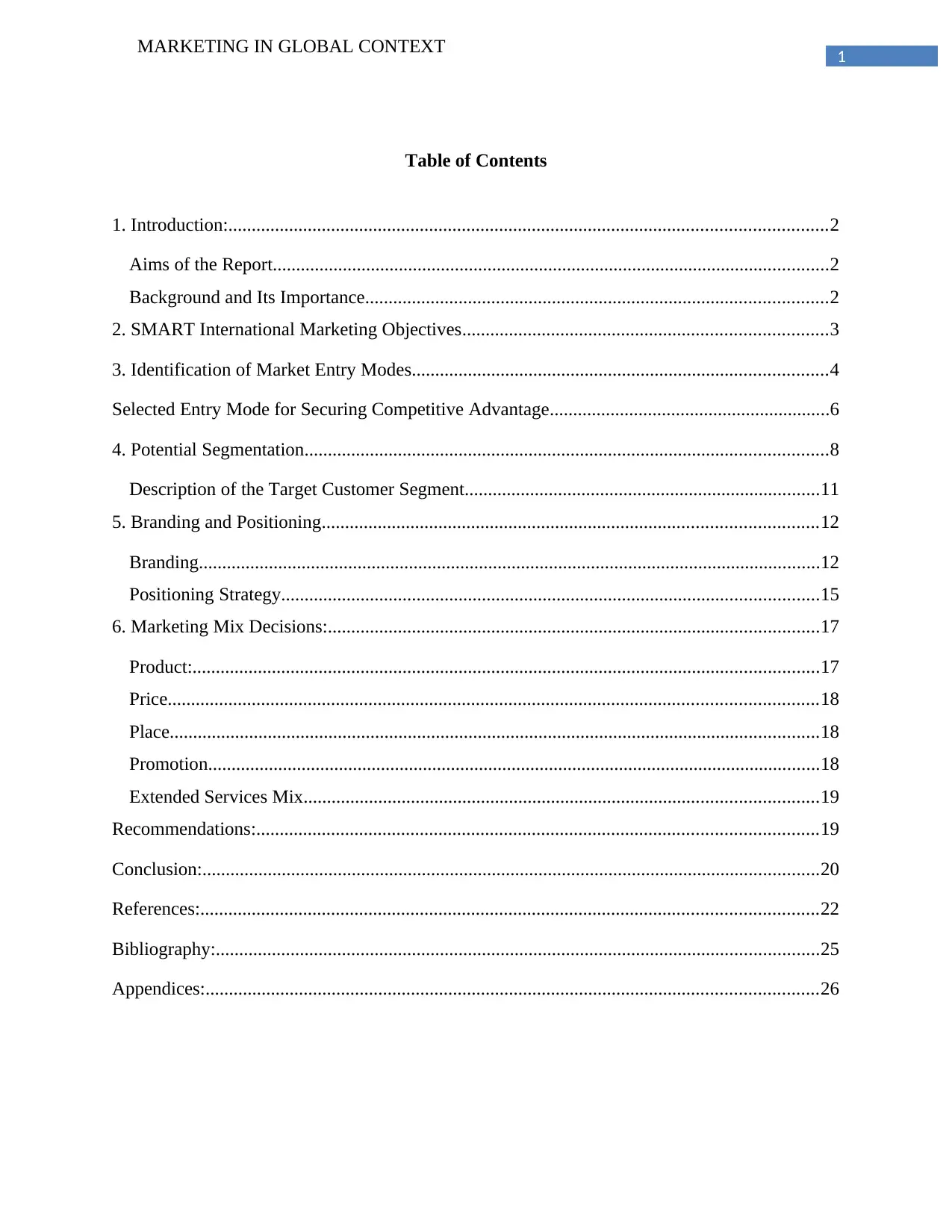
1
MARKETING IN GLOBAL CONTEXT
Table of Contents
1. Introduction:................................................................................................................................2
Aims of the Report.......................................................................................................................2
Background and Its Importance...................................................................................................2
2. SMART International Marketing Objectives..............................................................................3
3. Identification of Market Entry Modes.........................................................................................4
Selected Entry Mode for Securing Competitive Advantage............................................................6
4. Potential Segmentation................................................................................................................8
Description of the Target Customer Segment............................................................................11
5. Branding and Positioning..........................................................................................................12
Branding.....................................................................................................................................12
Positioning Strategy...................................................................................................................15
6. Marketing Mix Decisions:.........................................................................................................17
Product:......................................................................................................................................17
Price...........................................................................................................................................18
Place...........................................................................................................................................18
Promotion...................................................................................................................................18
Extended Services Mix..............................................................................................................19
Recommendations:........................................................................................................................19
Conclusion:....................................................................................................................................20
References:....................................................................................................................................22
Bibliography:.................................................................................................................................25
Appendices:...................................................................................................................................26
MARKETING IN GLOBAL CONTEXT
Table of Contents
1. Introduction:................................................................................................................................2
Aims of the Report.......................................................................................................................2
Background and Its Importance...................................................................................................2
2. SMART International Marketing Objectives..............................................................................3
3. Identification of Market Entry Modes.........................................................................................4
Selected Entry Mode for Securing Competitive Advantage............................................................6
4. Potential Segmentation................................................................................................................8
Description of the Target Customer Segment............................................................................11
5. Branding and Positioning..........................................................................................................12
Branding.....................................................................................................................................12
Positioning Strategy...................................................................................................................15
6. Marketing Mix Decisions:.........................................................................................................17
Product:......................................................................................................................................17
Price...........................................................................................................................................18
Place...........................................................................................................................................18
Promotion...................................................................................................................................18
Extended Services Mix..............................................................................................................19
Recommendations:........................................................................................................................19
Conclusion:....................................................................................................................................20
References:....................................................................................................................................22
Bibliography:.................................................................................................................................25
Appendices:...................................................................................................................................26
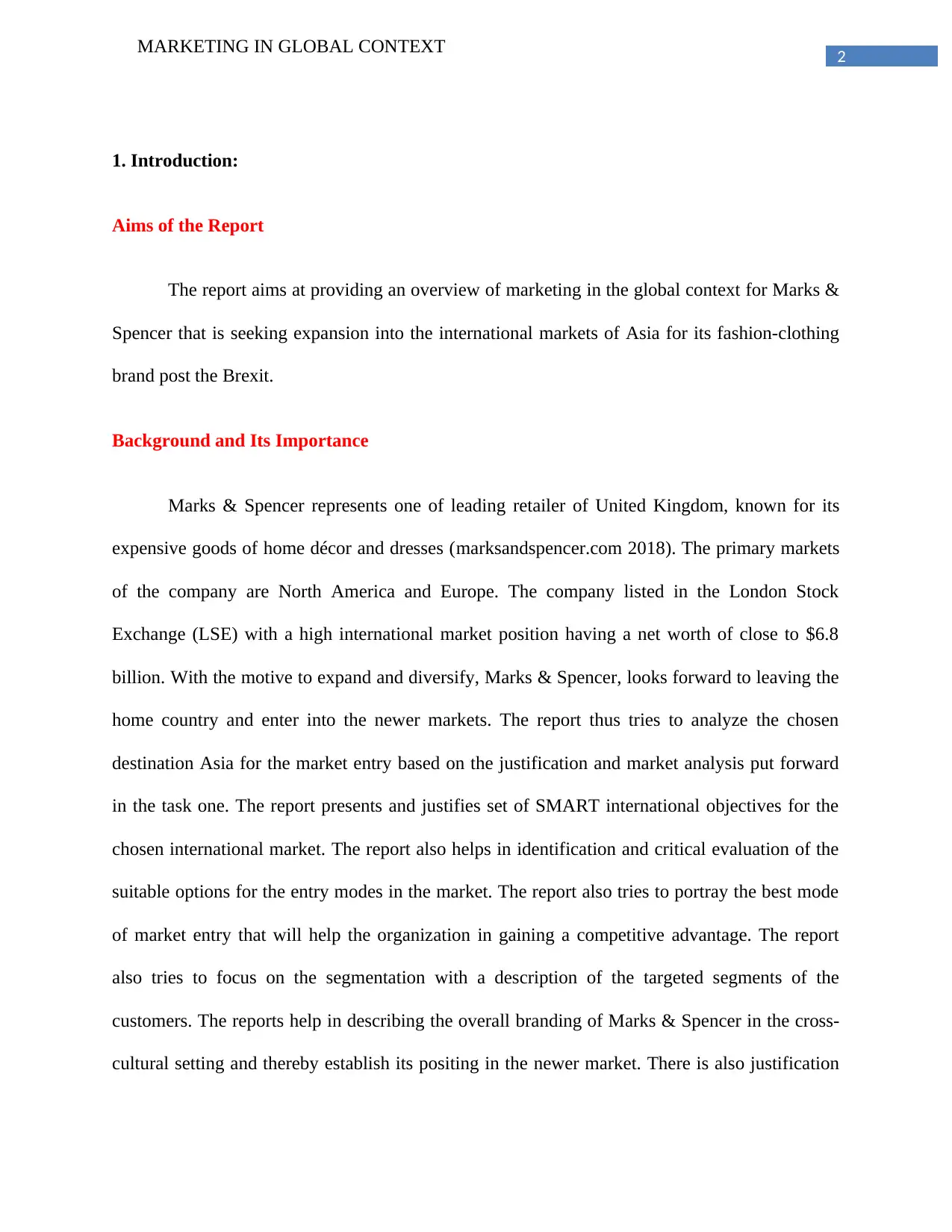
2
MARKETING IN GLOBAL CONTEXT
1. Introduction:
Aims of the Report
The report aims at providing an overview of marketing in the global context for Marks &
Spencer that is seeking expansion into the international markets of Asia for its fashion-clothing
brand post the Brexit.
Background and Its Importance
Marks & Spencer represents one of leading retailer of United Kingdom, known for its
expensive goods of home décor and dresses (marksandspencer.com 2018). The primary markets
of the company are North America and Europe. The company listed in the London Stock
Exchange (LSE) with a high international market position having a net worth of close to $6.8
billion. With the motive to expand and diversify, Marks & Spencer, looks forward to leaving the
home country and enter into the newer markets. The report thus tries to analyze the chosen
destination Asia for the market entry based on the justification and market analysis put forward
in the task one. The report presents and justifies set of SMART international objectives for the
chosen international market. The report also helps in identification and critical evaluation of the
suitable options for the entry modes in the market. The report also tries to portray the best mode
of market entry that will help the organization in gaining a competitive advantage. The report
also tries to focus on the segmentation with a description of the targeted segments of the
customers. The reports help in describing the overall branding of Marks & Spencer in the cross-
cultural setting and thereby establish its positing in the newer market. There is also justification
MARKETING IN GLOBAL CONTEXT
1. Introduction:
Aims of the Report
The report aims at providing an overview of marketing in the global context for Marks &
Spencer that is seeking expansion into the international markets of Asia for its fashion-clothing
brand post the Brexit.
Background and Its Importance
Marks & Spencer represents one of leading retailer of United Kingdom, known for its
expensive goods of home décor and dresses (marksandspencer.com 2018). The primary markets
of the company are North America and Europe. The company listed in the London Stock
Exchange (LSE) with a high international market position having a net worth of close to $6.8
billion. With the motive to expand and diversify, Marks & Spencer, looks forward to leaving the
home country and enter into the newer markets. The report thus tries to analyze the chosen
destination Asia for the market entry based on the justification and market analysis put forward
in the task one. The report presents and justifies set of SMART international objectives for the
chosen international market. The report also helps in identification and critical evaluation of the
suitable options for the entry modes in the market. The report also tries to portray the best mode
of market entry that will help the organization in gaining a competitive advantage. The report
also tries to focus on the segmentation with a description of the targeted segments of the
customers. The reports help in describing the overall branding of Marks & Spencer in the cross-
cultural setting and thereby establish its positing in the newer market. There is also justification
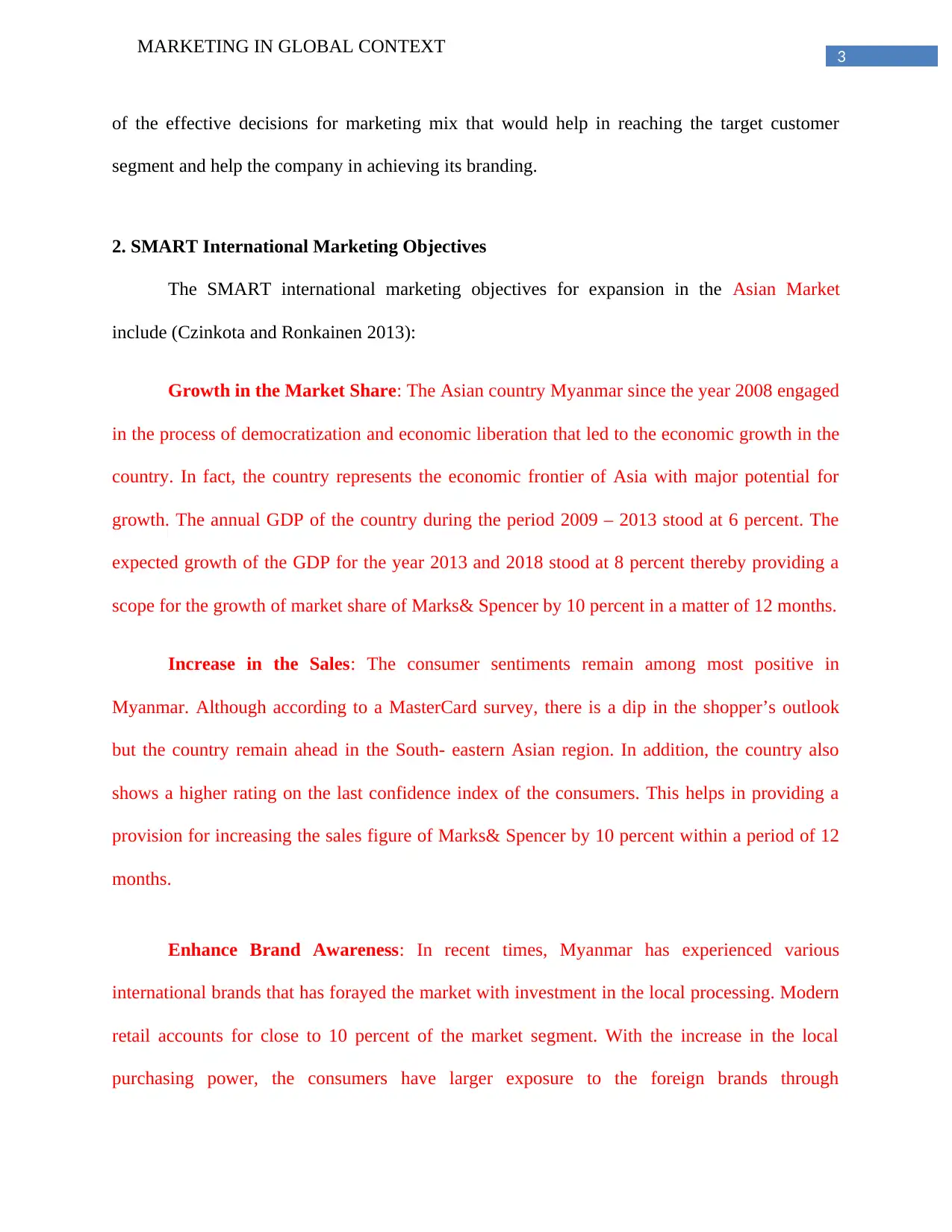
3
MARKETING IN GLOBAL CONTEXT
of the effective decisions for marketing mix that would help in reaching the target customer
segment and help the company in achieving its branding.
2. SMART International Marketing Objectives
The SMART international marketing objectives for expansion in the Asian Market
include (Czinkota and Ronkainen 2013):
Growth in the Market Share: The Asian country Myanmar since the year 2008 engaged
in the process of democratization and economic liberation that led to the economic growth in the
country. In fact, the country represents the economic frontier of Asia with major potential for
growth. The annual GDP of the country during the period 2009 – 2013 stood at 6 percent. The
expected growth of the GDP for the year 2013 and 2018 stood at 8 percent thereby providing a
scope for the growth of market share of Marks& Spencer by 10 percent in a matter of 12 months.
Increase in the Sales: The consumer sentiments remain among most positive in
Myanmar. Although according to a MasterCard survey, there is a dip in the shopper’s outlook
but the country remain ahead in the South- eastern Asian region. In addition, the country also
shows a higher rating on the last confidence index of the consumers. This helps in providing a
provision for increasing the sales figure of Marks& Spencer by 10 percent within a period of 12
months.
Enhance Brand Awareness: In recent times, Myanmar has experienced various
international brands that has forayed the market with investment in the local processing. Modern
retail accounts for close to 10 percent of the market segment. With the increase in the local
purchasing power, the consumers have larger exposure to the foreign brands through
MARKETING IN GLOBAL CONTEXT
of the effective decisions for marketing mix that would help in reaching the target customer
segment and help the company in achieving its branding.
2. SMART International Marketing Objectives
The SMART international marketing objectives for expansion in the Asian Market
include (Czinkota and Ronkainen 2013):
Growth in the Market Share: The Asian country Myanmar since the year 2008 engaged
in the process of democratization and economic liberation that led to the economic growth in the
country. In fact, the country represents the economic frontier of Asia with major potential for
growth. The annual GDP of the country during the period 2009 – 2013 stood at 6 percent. The
expected growth of the GDP for the year 2013 and 2018 stood at 8 percent thereby providing a
scope for the growth of market share of Marks& Spencer by 10 percent in a matter of 12 months.
Increase in the Sales: The consumer sentiments remain among most positive in
Myanmar. Although according to a MasterCard survey, there is a dip in the shopper’s outlook
but the country remain ahead in the South- eastern Asian region. In addition, the country also
shows a higher rating on the last confidence index of the consumers. This helps in providing a
provision for increasing the sales figure of Marks& Spencer by 10 percent within a period of 12
months.
Enhance Brand Awareness: In recent times, Myanmar has experienced various
international brands that has forayed the market with investment in the local processing. Modern
retail accounts for close to 10 percent of the market segment. With the increase in the local
purchasing power, the consumers have larger exposure to the foreign brands through
Secure Best Marks with AI Grader
Need help grading? Try our AI Grader for instant feedback on your assignments.
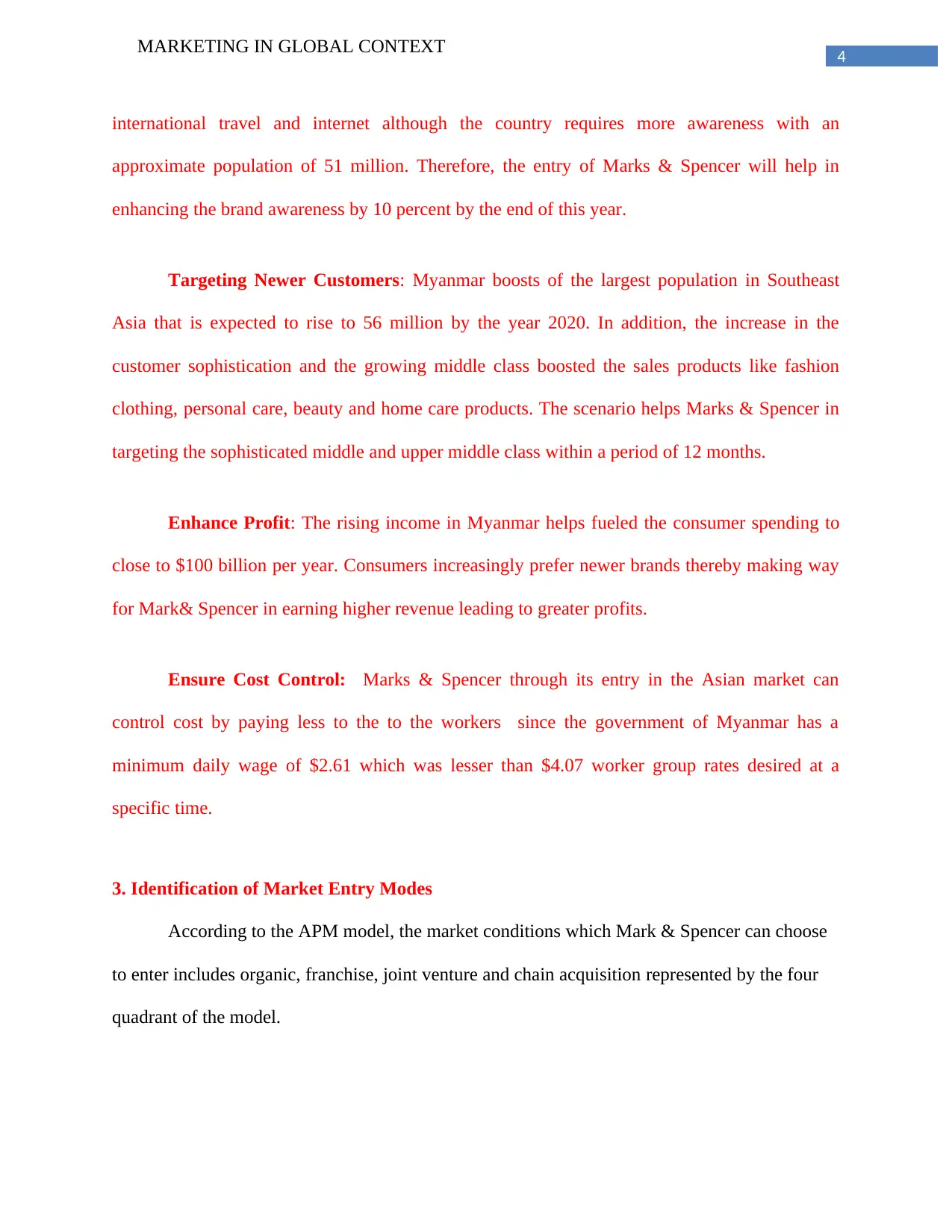
4
MARKETING IN GLOBAL CONTEXT
international travel and internet although the country requires more awareness with an
approximate population of 51 million. Therefore, the entry of Marks & Spencer will help in
enhancing the brand awareness by 10 percent by the end of this year.
Targeting Newer Customers: Myanmar boosts of the largest population in Southeast
Asia that is expected to rise to 56 million by the year 2020. In addition, the increase in the
customer sophistication and the growing middle class boosted the sales products like fashion
clothing, personal care, beauty and home care products. The scenario helps Marks & Spencer in
targeting the sophisticated middle and upper middle class within a period of 12 months.
Enhance Profit: The rising income in Myanmar helps fueled the consumer spending to
close to $100 billion per year. Consumers increasingly prefer newer brands thereby making way
for Mark& Spencer in earning higher revenue leading to greater profits.
Ensure Cost Control: Marks & Spencer through its entry in the Asian market can
control cost by paying less to the to the workers since the government of Myanmar has a
minimum daily wage of $2.61 which was lesser than $4.07 worker group rates desired at a
specific time.
3. Identification of Market Entry Modes
According to the APM model, the market conditions which Mark & Spencer can choose
to enter includes organic, franchise, joint venture and chain acquisition represented by the four
quadrant of the model.
MARKETING IN GLOBAL CONTEXT
international travel and internet although the country requires more awareness with an
approximate population of 51 million. Therefore, the entry of Marks & Spencer will help in
enhancing the brand awareness by 10 percent by the end of this year.
Targeting Newer Customers: Myanmar boosts of the largest population in Southeast
Asia that is expected to rise to 56 million by the year 2020. In addition, the increase in the
customer sophistication and the growing middle class boosted the sales products like fashion
clothing, personal care, beauty and home care products. The scenario helps Marks & Spencer in
targeting the sophisticated middle and upper middle class within a period of 12 months.
Enhance Profit: The rising income in Myanmar helps fueled the consumer spending to
close to $100 billion per year. Consumers increasingly prefer newer brands thereby making way
for Mark& Spencer in earning higher revenue leading to greater profits.
Ensure Cost Control: Marks & Spencer through its entry in the Asian market can
control cost by paying less to the to the workers since the government of Myanmar has a
minimum daily wage of $2.61 which was lesser than $4.07 worker group rates desired at a
specific time.
3. Identification of Market Entry Modes
According to the APM model, the market conditions which Mark & Spencer can choose
to enter includes organic, franchise, joint venture and chain acquisition represented by the four
quadrant of the model.
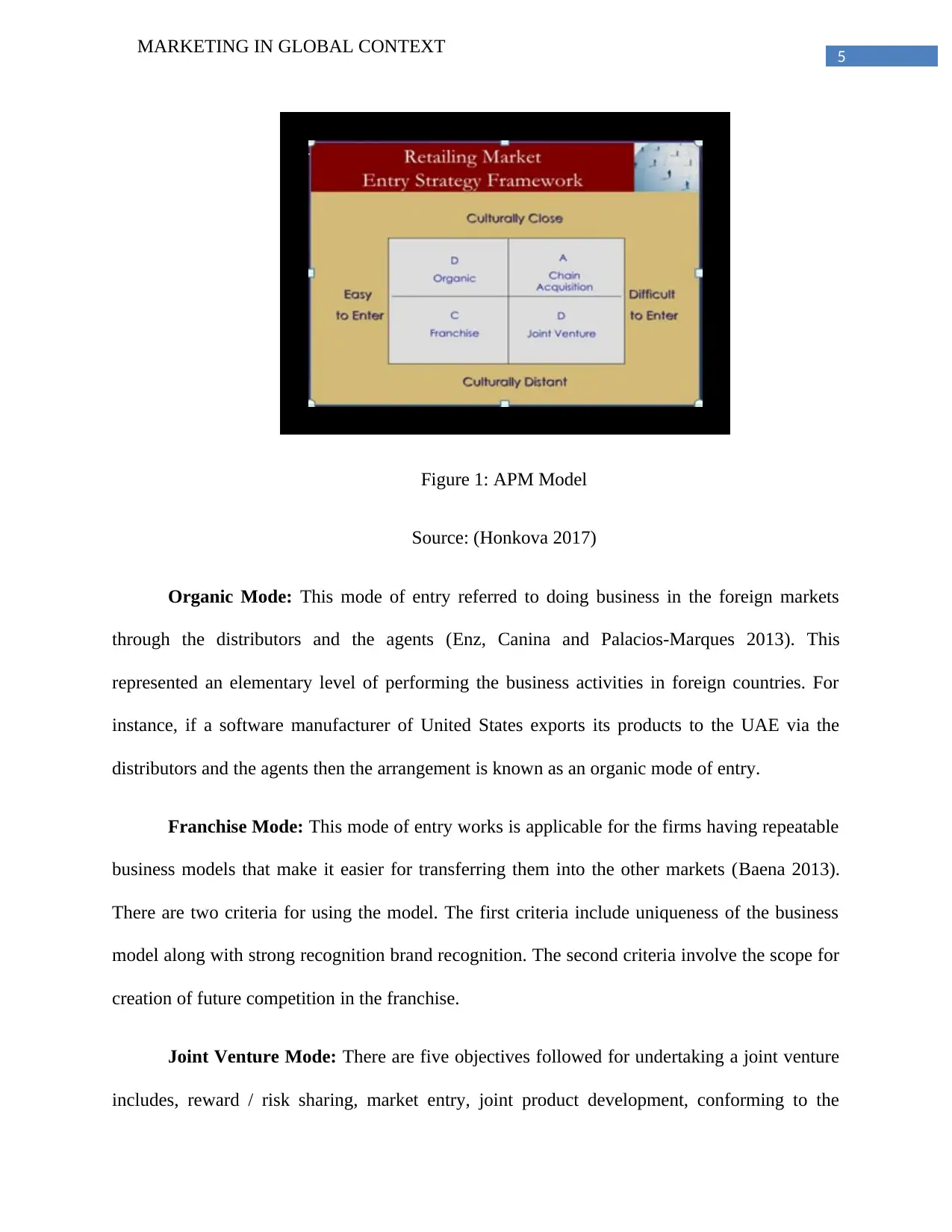
5
MARKETING IN GLOBAL CONTEXT
Figure 1: APM Model
Source: (Honkova 2017)
Organic Mode: This mode of entry referred to doing business in the foreign markets
through the distributors and the agents (Enz, Canina and Palacios-Marques 2013). This
represented an elementary level of performing the business activities in foreign countries. For
instance, if a software manufacturer of United States exports its products to the UAE via the
distributors and the agents then the arrangement is known as an organic mode of entry.
Franchise Mode: This mode of entry works is applicable for the firms having repeatable
business models that make it easier for transferring them into the other markets (Baena 2013).
There are two criteria for using the model. The first criteria include uniqueness of the business
model along with strong recognition brand recognition. The second criteria involve the scope for
creation of future competition in the franchise.
Joint Venture Mode: There are five objectives followed for undertaking a joint venture
includes, reward / risk sharing, market entry, joint product development, conforming to the
MARKETING IN GLOBAL CONTEXT
Figure 1: APM Model
Source: (Honkova 2017)
Organic Mode: This mode of entry referred to doing business in the foreign markets
through the distributors and the agents (Enz, Canina and Palacios-Marques 2013). This
represented an elementary level of performing the business activities in foreign countries. For
instance, if a software manufacturer of United States exports its products to the UAE via the
distributors and the agents then the arrangement is known as an organic mode of entry.
Franchise Mode: This mode of entry works is applicable for the firms having repeatable
business models that make it easier for transferring them into the other markets (Baena 2013).
There are two criteria for using the model. The first criteria include uniqueness of the business
model along with strong recognition brand recognition. The second criteria involve the scope for
creation of future competition in the franchise.
Joint Venture Mode: There are five objectives followed for undertaking a joint venture
includes, reward / risk sharing, market entry, joint product development, conforming to the
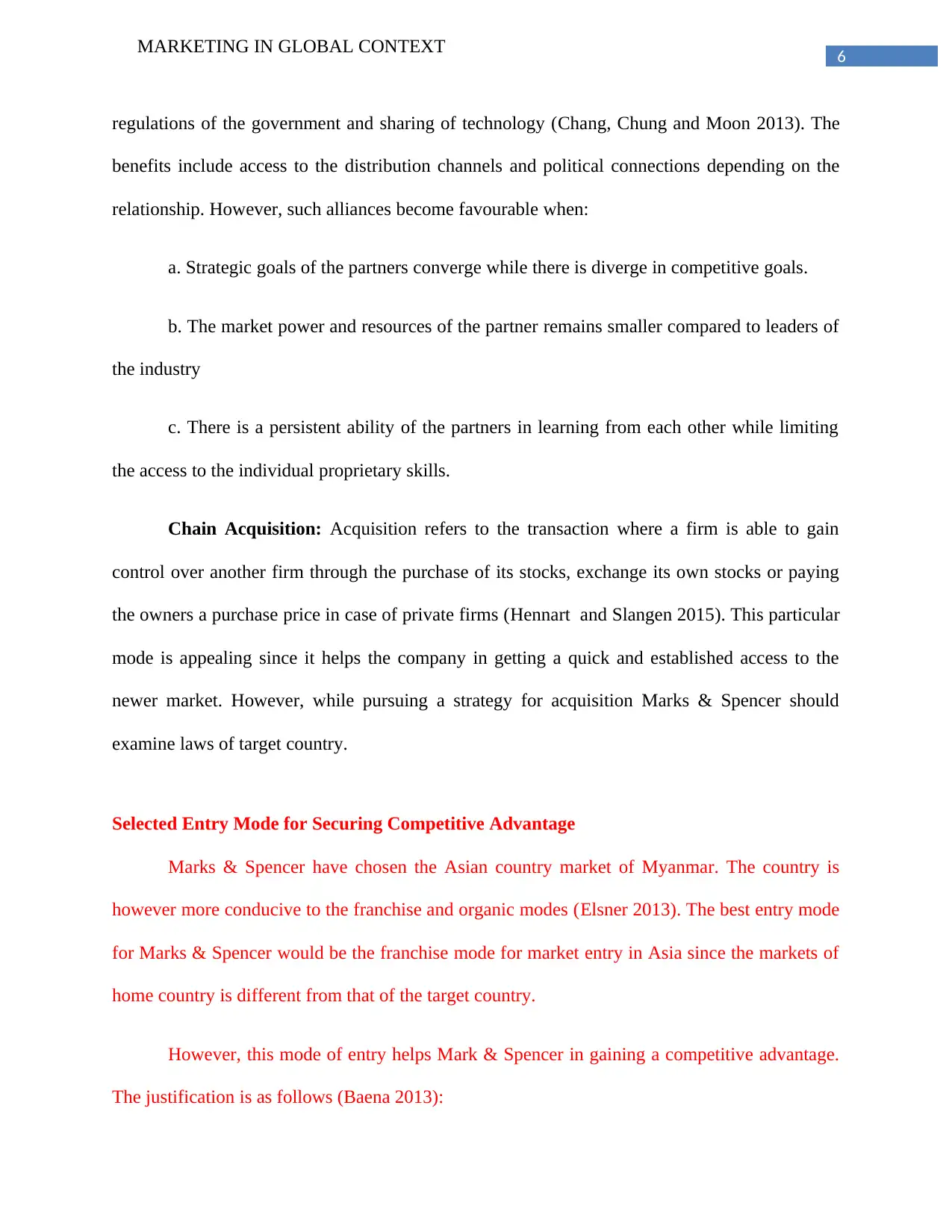
6
MARKETING IN GLOBAL CONTEXT
regulations of the government and sharing of technology (Chang, Chung and Moon 2013). The
benefits include access to the distribution channels and political connections depending on the
relationship. However, such alliances become favourable when:
a. Strategic goals of the partners converge while there is diverge in competitive goals.
b. The market power and resources of the partner remains smaller compared to leaders of
the industry
c. There is a persistent ability of the partners in learning from each other while limiting
the access to the individual proprietary skills.
Chain Acquisition: Acquisition refers to the transaction where a firm is able to gain
control over another firm through the purchase of its stocks, exchange its own stocks or paying
the owners a purchase price in case of private firms (Hennart and Slangen 2015). This particular
mode is appealing since it helps the company in getting a quick and established access to the
newer market. However, while pursuing a strategy for acquisition Marks & Spencer should
examine laws of target country.
Selected Entry Mode for Securing Competitive Advantage
Marks & Spencer have chosen the Asian country market of Myanmar. The country is
however more conducive to the franchise and organic modes (Elsner 2013). The best entry mode
for Marks & Spencer would be the franchise mode for market entry in Asia since the markets of
home country is different from that of the target country.
However, this mode of entry helps Mark & Spencer in gaining a competitive advantage.
The justification is as follows (Baena 2013):
MARKETING IN GLOBAL CONTEXT
regulations of the government and sharing of technology (Chang, Chung and Moon 2013). The
benefits include access to the distribution channels and political connections depending on the
relationship. However, such alliances become favourable when:
a. Strategic goals of the partners converge while there is diverge in competitive goals.
b. The market power and resources of the partner remains smaller compared to leaders of
the industry
c. There is a persistent ability of the partners in learning from each other while limiting
the access to the individual proprietary skills.
Chain Acquisition: Acquisition refers to the transaction where a firm is able to gain
control over another firm through the purchase of its stocks, exchange its own stocks or paying
the owners a purchase price in case of private firms (Hennart and Slangen 2015). This particular
mode is appealing since it helps the company in getting a quick and established access to the
newer market. However, while pursuing a strategy for acquisition Marks & Spencer should
examine laws of target country.
Selected Entry Mode for Securing Competitive Advantage
Marks & Spencer have chosen the Asian country market of Myanmar. The country is
however more conducive to the franchise and organic modes (Elsner 2013). The best entry mode
for Marks & Spencer would be the franchise mode for market entry in Asia since the markets of
home country is different from that of the target country.
However, this mode of entry helps Mark & Spencer in gaining a competitive advantage.
The justification is as follows (Baena 2013):
Paraphrase This Document
Need a fresh take? Get an instant paraphrase of this document with our AI Paraphraser
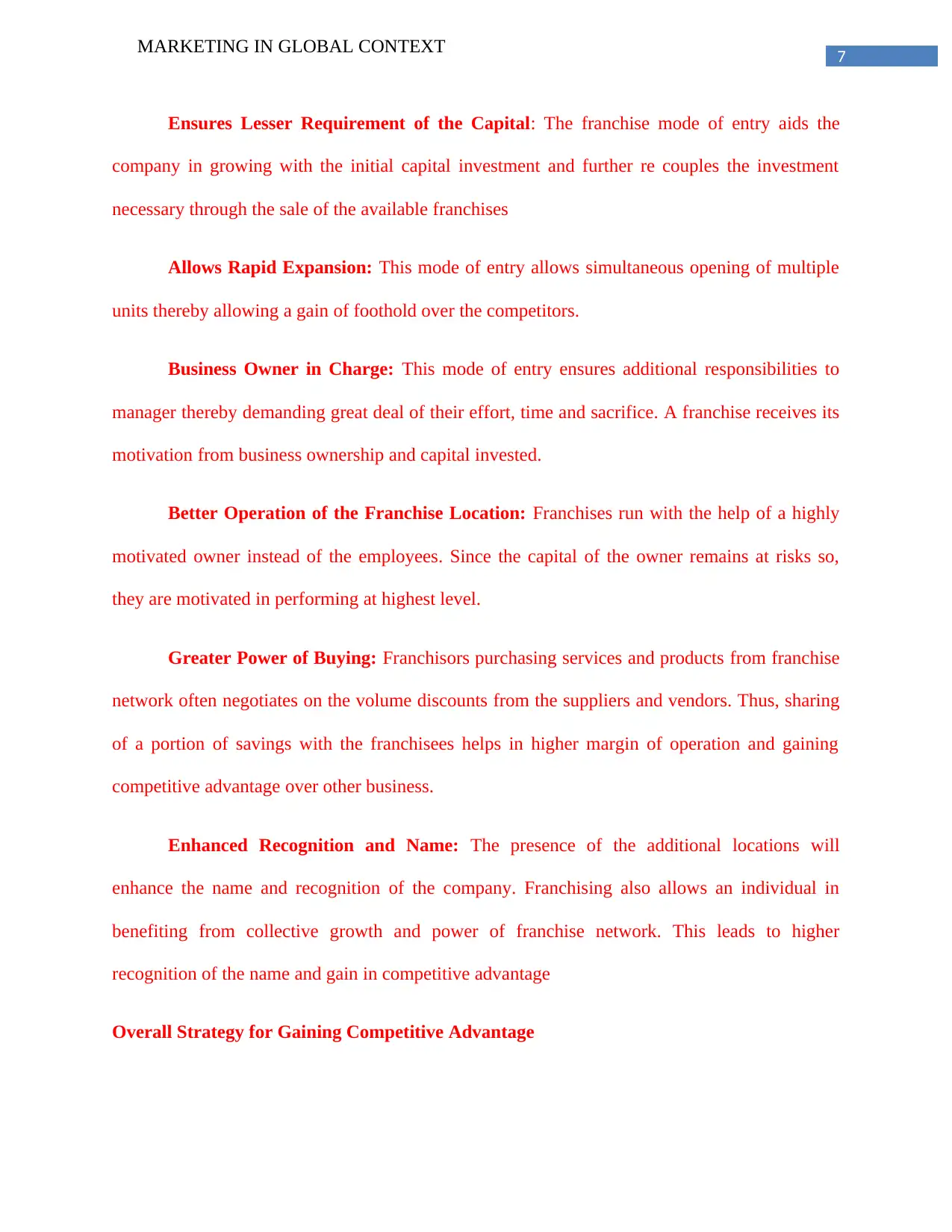
7
MARKETING IN GLOBAL CONTEXT
Ensures Lesser Requirement of the Capital: The franchise mode of entry aids the
company in growing with the initial capital investment and further re couples the investment
necessary through the sale of the available franchises
Allows Rapid Expansion: This mode of entry allows simultaneous opening of multiple
units thereby allowing a gain of foothold over the competitors.
Business Owner in Charge: This mode of entry ensures additional responsibilities to
manager thereby demanding great deal of their effort, time and sacrifice. A franchise receives its
motivation from business ownership and capital invested.
Better Operation of the Franchise Location: Franchises run with the help of a highly
motivated owner instead of the employees. Since the capital of the owner remains at risks so,
they are motivated in performing at highest level.
Greater Power of Buying: Franchisors purchasing services and products from franchise
network often negotiates on the volume discounts from the suppliers and vendors. Thus, sharing
of a portion of savings with the franchisees helps in higher margin of operation and gaining
competitive advantage over other business.
Enhanced Recognition and Name: The presence of the additional locations will
enhance the name and recognition of the company. Franchising also allows an individual in
benefiting from collective growth and power of franchise network. This leads to higher
recognition of the name and gain in competitive advantage
Overall Strategy for Gaining Competitive Advantage
MARKETING IN GLOBAL CONTEXT
Ensures Lesser Requirement of the Capital: The franchise mode of entry aids the
company in growing with the initial capital investment and further re couples the investment
necessary through the sale of the available franchises
Allows Rapid Expansion: This mode of entry allows simultaneous opening of multiple
units thereby allowing a gain of foothold over the competitors.
Business Owner in Charge: This mode of entry ensures additional responsibilities to
manager thereby demanding great deal of their effort, time and sacrifice. A franchise receives its
motivation from business ownership and capital invested.
Better Operation of the Franchise Location: Franchises run with the help of a highly
motivated owner instead of the employees. Since the capital of the owner remains at risks so,
they are motivated in performing at highest level.
Greater Power of Buying: Franchisors purchasing services and products from franchise
network often negotiates on the volume discounts from the suppliers and vendors. Thus, sharing
of a portion of savings with the franchisees helps in higher margin of operation and gaining
competitive advantage over other business.
Enhanced Recognition and Name: The presence of the additional locations will
enhance the name and recognition of the company. Franchising also allows an individual in
benefiting from collective growth and power of franchise network. This leads to higher
recognition of the name and gain in competitive advantage
Overall Strategy for Gaining Competitive Advantage
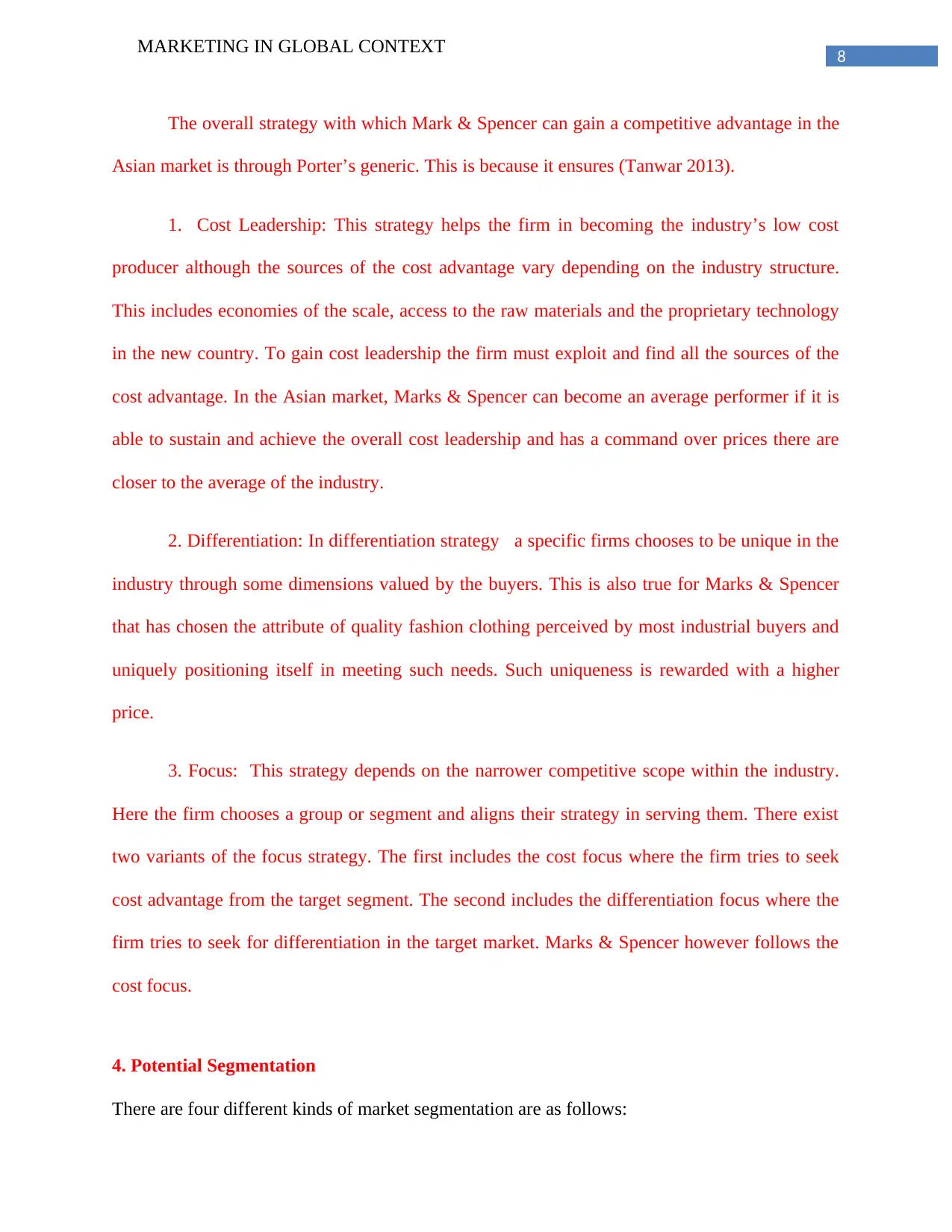
8
MARKETING IN GLOBAL CONTEXT
The overall strategy with which Mark & Spencer can gain a competitive advantage in the
Asian market is through Porter’s generic. This is because it ensures (Tanwar 2013).
1. Cost Leadership: This strategy helps the firm in becoming the industry’s low cost
producer although the sources of the cost advantage vary depending on the industry structure.
This includes economies of the scale, access to the raw materials and the proprietary technology
in the new country. To gain cost leadership the firm must exploit and find all the sources of the
cost advantage. In the Asian market, Marks & Spencer can become an average performer if it is
able to sustain and achieve the overall cost leadership and has a command over prices there are
closer to the average of the industry.
2. Differentiation: In differentiation strategy a specific firms chooses to be unique in the
industry through some dimensions valued by the buyers. This is also true for Marks & Spencer
that has chosen the attribute of quality fashion clothing perceived by most industrial buyers and
uniquely positioning itself in meeting such needs. Such uniqueness is rewarded with a higher
price.
3. Focus: This strategy depends on the narrower competitive scope within the industry.
Here the firm chooses a group or segment and aligns their strategy in serving them. There exist
two variants of the focus strategy. The first includes the cost focus where the firm tries to seek
cost advantage from the target segment. The second includes the differentiation focus where the
firm tries to seek for differentiation in the target market. Marks & Spencer however follows the
cost focus.
4. Potential Segmentation
There are four different kinds of market segmentation are as follows:
MARKETING IN GLOBAL CONTEXT
The overall strategy with which Mark & Spencer can gain a competitive advantage in the
Asian market is through Porter’s generic. This is because it ensures (Tanwar 2013).
1. Cost Leadership: This strategy helps the firm in becoming the industry’s low cost
producer although the sources of the cost advantage vary depending on the industry structure.
This includes economies of the scale, access to the raw materials and the proprietary technology
in the new country. To gain cost leadership the firm must exploit and find all the sources of the
cost advantage. In the Asian market, Marks & Spencer can become an average performer if it is
able to sustain and achieve the overall cost leadership and has a command over prices there are
closer to the average of the industry.
2. Differentiation: In differentiation strategy a specific firms chooses to be unique in the
industry through some dimensions valued by the buyers. This is also true for Marks & Spencer
that has chosen the attribute of quality fashion clothing perceived by most industrial buyers and
uniquely positioning itself in meeting such needs. Such uniqueness is rewarded with a higher
price.
3. Focus: This strategy depends on the narrower competitive scope within the industry.
Here the firm chooses a group or segment and aligns their strategy in serving them. There exist
two variants of the focus strategy. The first includes the cost focus where the firm tries to seek
cost advantage from the target segment. The second includes the differentiation focus where the
firm tries to seek for differentiation in the target market. Marks & Spencer however follows the
cost focus.
4. Potential Segmentation
There are four different kinds of market segmentation are as follows:
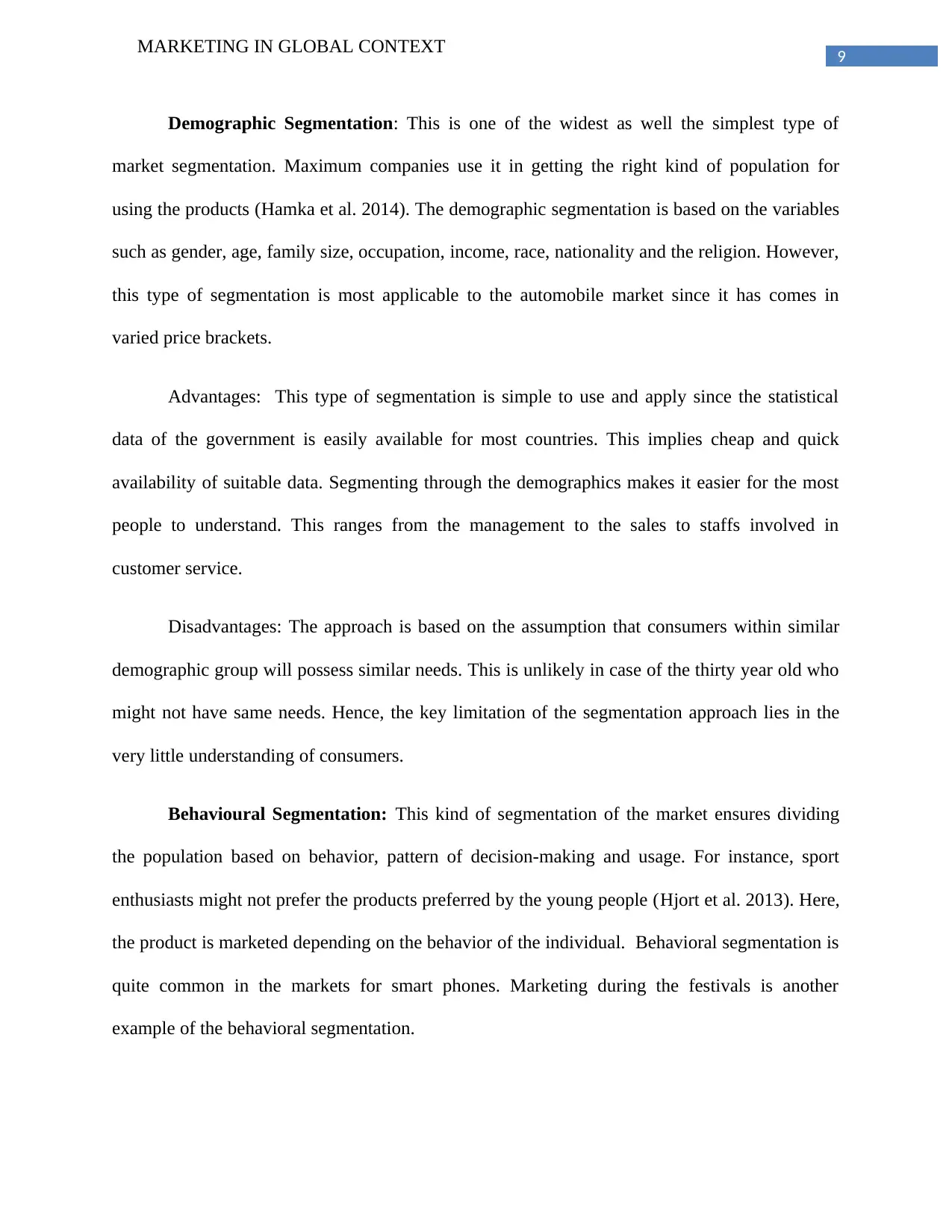
9
MARKETING IN GLOBAL CONTEXT
Demographic Segmentation: This is one of the widest as well the simplest type of
market segmentation. Maximum companies use it in getting the right kind of population for
using the products (Hamka et al. 2014). The demographic segmentation is based on the variables
such as gender, age, family size, occupation, income, race, nationality and the religion. However,
this type of segmentation is most applicable to the automobile market since it has comes in
varied price brackets.
Advantages: This type of segmentation is simple to use and apply since the statistical
data of the government is easily available for most countries. This implies cheap and quick
availability of suitable data. Segmenting through the demographics makes it easier for the most
people to understand. This ranges from the management to the sales to staffs involved in
customer service.
Disadvantages: The approach is based on the assumption that consumers within similar
demographic group will possess similar needs. This is unlikely in case of the thirty year old who
might not have same needs. Hence, the key limitation of the segmentation approach lies in the
very little understanding of consumers.
Behavioural Segmentation: This kind of segmentation of the market ensures dividing
the population based on behavior, pattern of decision-making and usage. For instance, sport
enthusiasts might not prefer the products preferred by the young people (Hjort et al. 2013). Here,
the product is marketed depending on the behavior of the individual. Behavioral segmentation is
quite common in the markets for smart phones. Marketing during the festivals is another
example of the behavioral segmentation.
MARKETING IN GLOBAL CONTEXT
Demographic Segmentation: This is one of the widest as well the simplest type of
market segmentation. Maximum companies use it in getting the right kind of population for
using the products (Hamka et al. 2014). The demographic segmentation is based on the variables
such as gender, age, family size, occupation, income, race, nationality and the religion. However,
this type of segmentation is most applicable to the automobile market since it has comes in
varied price brackets.
Advantages: This type of segmentation is simple to use and apply since the statistical
data of the government is easily available for most countries. This implies cheap and quick
availability of suitable data. Segmenting through the demographics makes it easier for the most
people to understand. This ranges from the management to the sales to staffs involved in
customer service.
Disadvantages: The approach is based on the assumption that consumers within similar
demographic group will possess similar needs. This is unlikely in case of the thirty year old who
might not have same needs. Hence, the key limitation of the segmentation approach lies in the
very little understanding of consumers.
Behavioural Segmentation: This kind of segmentation of the market ensures dividing
the population based on behavior, pattern of decision-making and usage. For instance, sport
enthusiasts might not prefer the products preferred by the young people (Hjort et al. 2013). Here,
the product is marketed depending on the behavior of the individual. Behavioral segmentation is
quite common in the markets for smart phones. Marketing during the festivals is another
example of the behavioral segmentation.
Secure Best Marks with AI Grader
Need help grading? Try our AI Grader for instant feedback on your assignments.
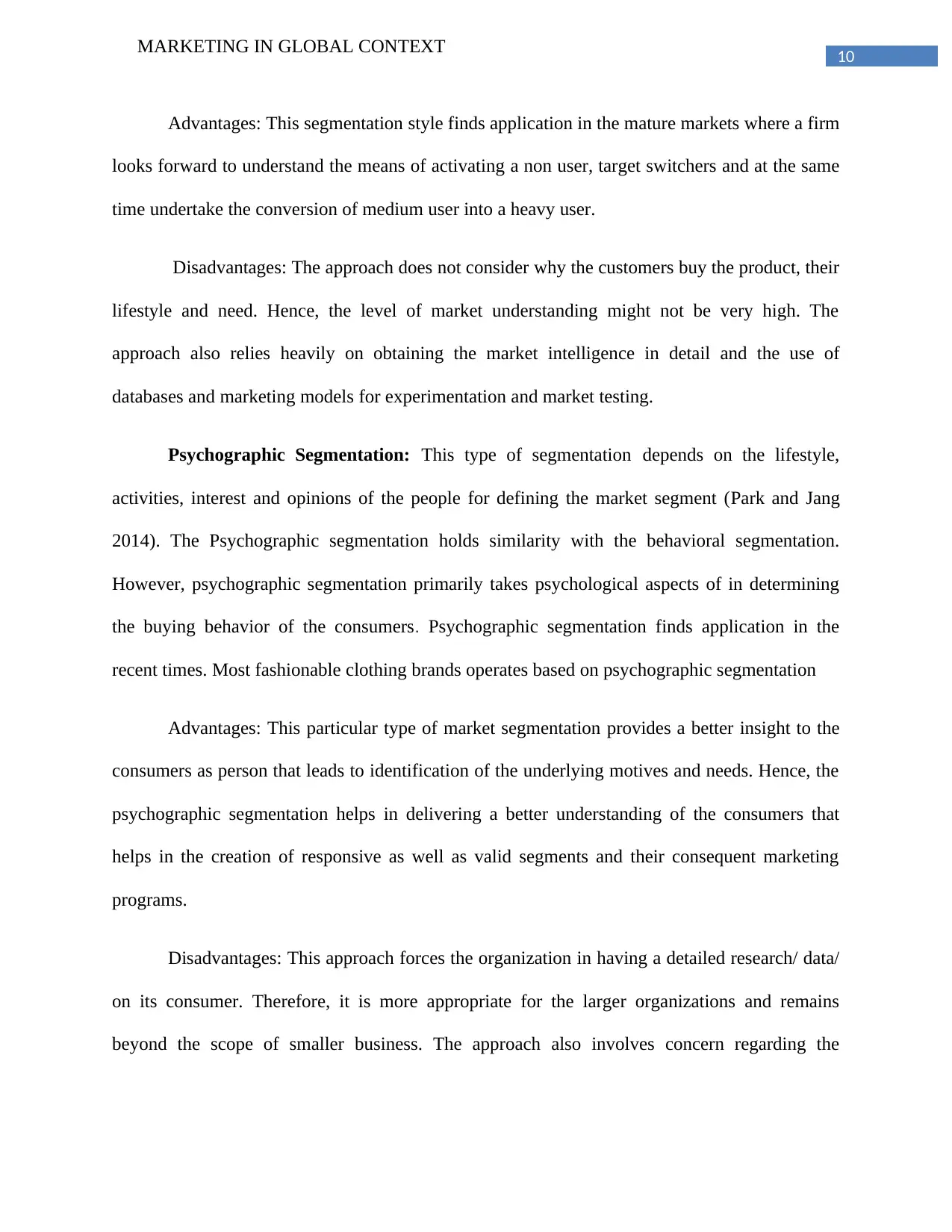
10
MARKETING IN GLOBAL CONTEXT
Advantages: This segmentation style finds application in the mature markets where a firm
looks forward to understand the means of activating a non user, target switchers and at the same
time undertake the conversion of medium user into a heavy user.
Disadvantages: The approach does not consider why the customers buy the product, their
lifestyle and need. Hence, the level of market understanding might not be very high. The
approach also relies heavily on obtaining the market intelligence in detail and the use of
databases and marketing models for experimentation and market testing.
Psychographic Segmentation: This type of segmentation depends on the lifestyle,
activities, interest and opinions of the people for defining the market segment (Park and Jang
2014). The Psychographic segmentation holds similarity with the behavioral segmentation.
However, psychographic segmentation primarily takes psychological aspects of in determining
the buying behavior of the consumers. Psychographic segmentation finds application in the
recent times. Most fashionable clothing brands operates based on psychographic segmentation
Advantages: This particular type of market segmentation provides a better insight to the
consumers as person that leads to identification of the underlying motives and needs. Hence, the
psychographic segmentation helps in delivering a better understanding of the consumers that
helps in the creation of responsive as well as valid segments and their consequent marketing
programs.
Disadvantages: This approach forces the organization in having a detailed research/ data/
on its consumer. Therefore, it is more appropriate for the larger organizations and remains
beyond the scope of smaller business. The approach also involves concern regarding the
MARKETING IN GLOBAL CONTEXT
Advantages: This segmentation style finds application in the mature markets where a firm
looks forward to understand the means of activating a non user, target switchers and at the same
time undertake the conversion of medium user into a heavy user.
Disadvantages: The approach does not consider why the customers buy the product, their
lifestyle and need. Hence, the level of market understanding might not be very high. The
approach also relies heavily on obtaining the market intelligence in detail and the use of
databases and marketing models for experimentation and market testing.
Psychographic Segmentation: This type of segmentation depends on the lifestyle,
activities, interest and opinions of the people for defining the market segment (Park and Jang
2014). The Psychographic segmentation holds similarity with the behavioral segmentation.
However, psychographic segmentation primarily takes psychological aspects of in determining
the buying behavior of the consumers. Psychographic segmentation finds application in the
recent times. Most fashionable clothing brands operates based on psychographic segmentation
Advantages: This particular type of market segmentation provides a better insight to the
consumers as person that leads to identification of the underlying motives and needs. Hence, the
psychographic segmentation helps in delivering a better understanding of the consumers that
helps in the creation of responsive as well as valid segments and their consequent marketing
programs.
Disadvantages: This approach forces the organization in having a detailed research/ data/
on its consumer. Therefore, it is more appropriate for the larger organizations and remains
beyond the scope of smaller business. The approach also involves concern regarding the
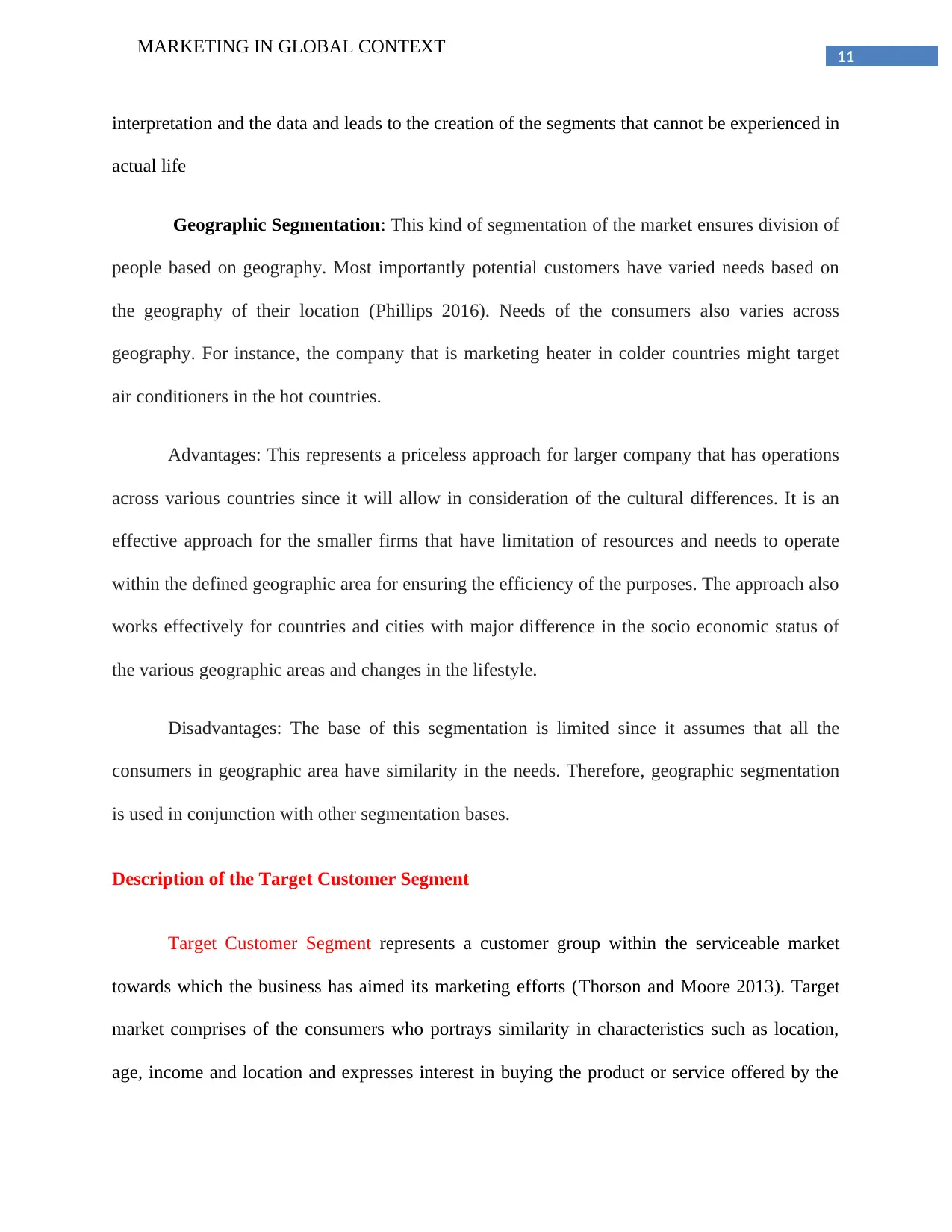
11
MARKETING IN GLOBAL CONTEXT
interpretation and the data and leads to the creation of the segments that cannot be experienced in
actual life
Geographic Segmentation: This kind of segmentation of the market ensures division of
people based on geography. Most importantly potential customers have varied needs based on
the geography of their location (Phillips 2016). Needs of the consumers also varies across
geography. For instance, the company that is marketing heater in colder countries might target
air conditioners in the hot countries.
Advantages: This represents a priceless approach for larger company that has operations
across various countries since it will allow in consideration of the cultural differences. It is an
effective approach for the smaller firms that have limitation of resources and needs to operate
within the defined geographic area for ensuring the efficiency of the purposes. The approach also
works effectively for countries and cities with major difference in the socio economic status of
the various geographic areas and changes in the lifestyle.
Disadvantages: The base of this segmentation is limited since it assumes that all the
consumers in geographic area have similarity in the needs. Therefore, geographic segmentation
is used in conjunction with other segmentation bases.
Description of the Target Customer Segment
Target Customer Segment represents a customer group within the serviceable market
towards which the business has aimed its marketing efforts (Thorson and Moore 2013). Target
market comprises of the consumers who portrays similarity in characteristics such as location,
age, income and location and expresses interest in buying the product or service offered by the
MARKETING IN GLOBAL CONTEXT
interpretation and the data and leads to the creation of the segments that cannot be experienced in
actual life
Geographic Segmentation: This kind of segmentation of the market ensures division of
people based on geography. Most importantly potential customers have varied needs based on
the geography of their location (Phillips 2016). Needs of the consumers also varies across
geography. For instance, the company that is marketing heater in colder countries might target
air conditioners in the hot countries.
Advantages: This represents a priceless approach for larger company that has operations
across various countries since it will allow in consideration of the cultural differences. It is an
effective approach for the smaller firms that have limitation of resources and needs to operate
within the defined geographic area for ensuring the efficiency of the purposes. The approach also
works effectively for countries and cities with major difference in the socio economic status of
the various geographic areas and changes in the lifestyle.
Disadvantages: The base of this segmentation is limited since it assumes that all the
consumers in geographic area have similarity in the needs. Therefore, geographic segmentation
is used in conjunction with other segmentation bases.
Description of the Target Customer Segment
Target Customer Segment represents a customer group within the serviceable market
towards which the business has aimed its marketing efforts (Thorson and Moore 2013). Target
market comprises of the consumers who portrays similarity in characteristics such as location,
age, income and location and expresses interest in buying the product or service offered by the
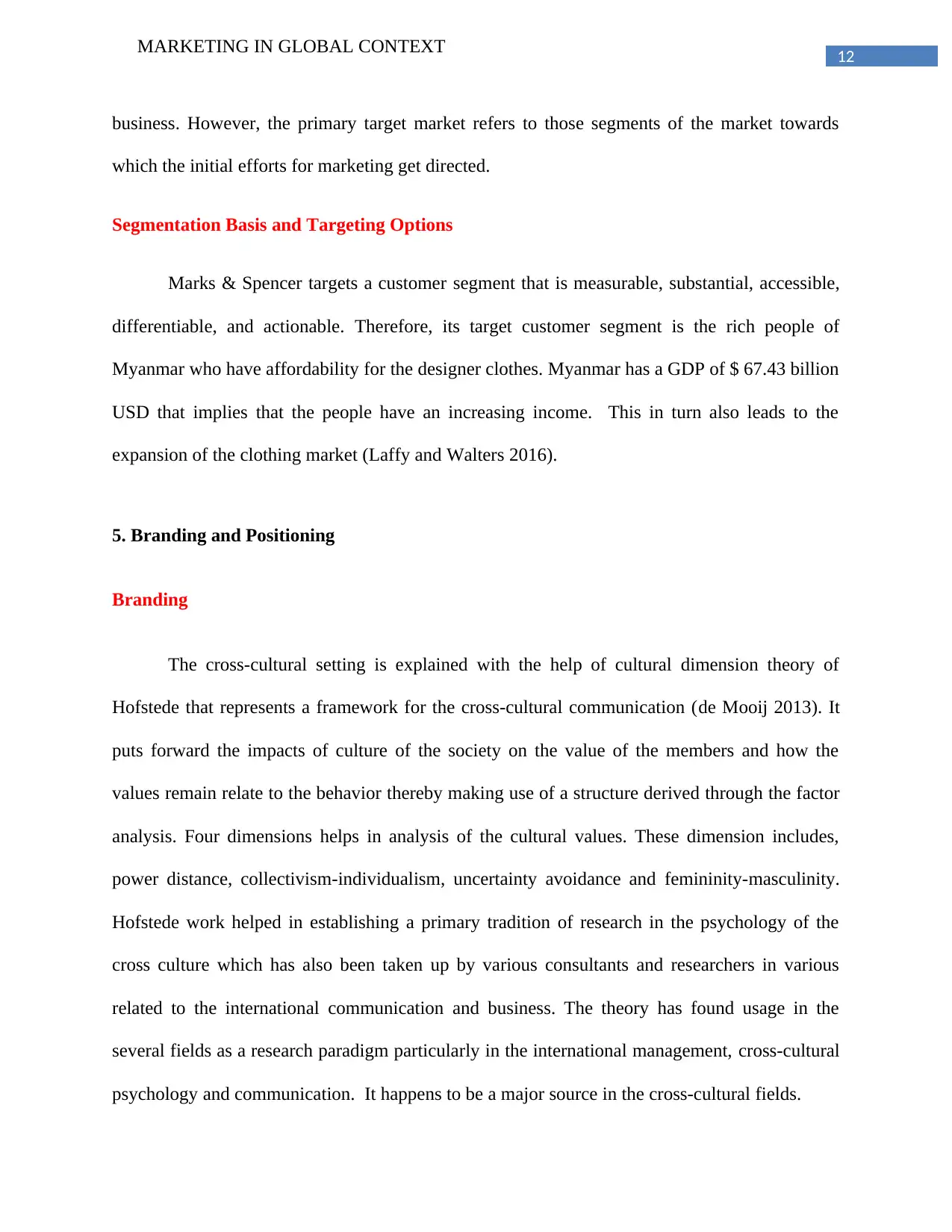
12
MARKETING IN GLOBAL CONTEXT
business. However, the primary target market refers to those segments of the market towards
which the initial efforts for marketing get directed.
Segmentation Basis and Targeting Options
Marks & Spencer targets a customer segment that is measurable, substantial, accessible,
differentiable, and actionable. Therefore, its target customer segment is the rich people of
Myanmar who have affordability for the designer clothes. Myanmar has a GDP of $ 67.43 billion
USD that implies that the people have an increasing income. This in turn also leads to the
expansion of the clothing market (Laffy and Walters 2016).
5. Branding and Positioning
Branding
The cross-cultural setting is explained with the help of cultural dimension theory of
Hofstede that represents a framework for the cross-cultural communication (de Mooij 2013). It
puts forward the impacts of culture of the society on the value of the members and how the
values remain relate to the behavior thereby making use of a structure derived through the factor
analysis. Four dimensions helps in analysis of the cultural values. These dimension includes,
power distance, collectivism-individualism, uncertainty avoidance and femininity-masculinity.
Hofstede work helped in establishing a primary tradition of research in the psychology of the
cross culture which has also been taken up by various consultants and researchers in various
related to the international communication and business. The theory has found usage in the
several fields as a research paradigm particularly in the international management, cross-cultural
psychology and communication. It happens to be a major source in the cross-cultural fields.
MARKETING IN GLOBAL CONTEXT
business. However, the primary target market refers to those segments of the market towards
which the initial efforts for marketing get directed.
Segmentation Basis and Targeting Options
Marks & Spencer targets a customer segment that is measurable, substantial, accessible,
differentiable, and actionable. Therefore, its target customer segment is the rich people of
Myanmar who have affordability for the designer clothes. Myanmar has a GDP of $ 67.43 billion
USD that implies that the people have an increasing income. This in turn also leads to the
expansion of the clothing market (Laffy and Walters 2016).
5. Branding and Positioning
Branding
The cross-cultural setting is explained with the help of cultural dimension theory of
Hofstede that represents a framework for the cross-cultural communication (de Mooij 2013). It
puts forward the impacts of culture of the society on the value of the members and how the
values remain relate to the behavior thereby making use of a structure derived through the factor
analysis. Four dimensions helps in analysis of the cultural values. These dimension includes,
power distance, collectivism-individualism, uncertainty avoidance and femininity-masculinity.
Hofstede work helped in establishing a primary tradition of research in the psychology of the
cross culture which has also been taken up by various consultants and researchers in various
related to the international communication and business. The theory has found usage in the
several fields as a research paradigm particularly in the international management, cross-cultural
psychology and communication. It happens to be a major source in the cross-cultural fields.
Paraphrase This Document
Need a fresh take? Get an instant paraphrase of this document with our AI Paraphraser
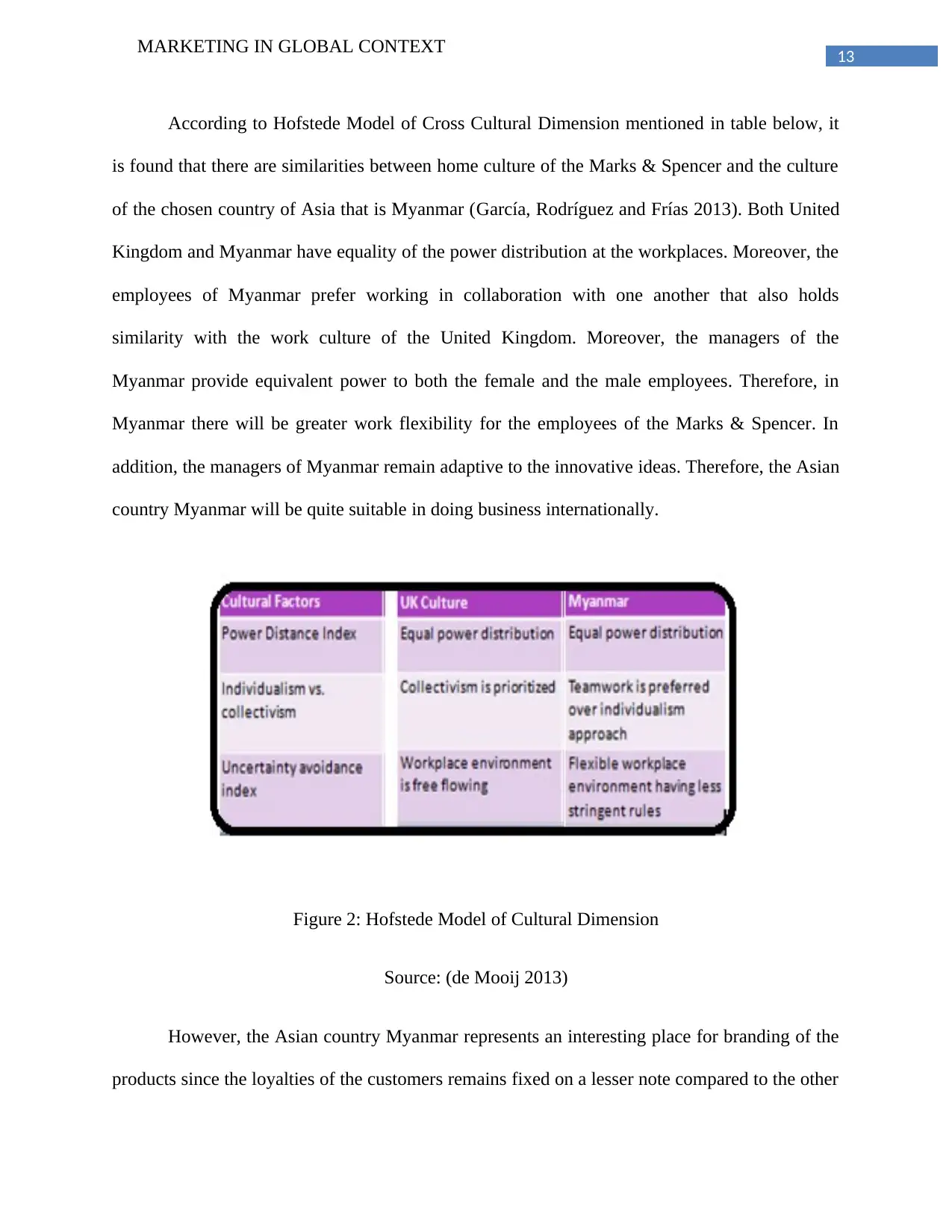
13
MARKETING IN GLOBAL CONTEXT
According to Hofstede Model of Cross Cultural Dimension mentioned in table below, it
is found that there are similarities between home culture of the Marks & Spencer and the culture
of the chosen country of Asia that is Myanmar (García, Rodríguez and Frías 2013). Both United
Kingdom and Myanmar have equality of the power distribution at the workplaces. Moreover, the
employees of Myanmar prefer working in collaboration with one another that also holds
similarity with the work culture of the United Kingdom. Moreover, the managers of the
Myanmar provide equivalent power to both the female and the male employees. Therefore, in
Myanmar there will be greater work flexibility for the employees of the Marks & Spencer. In
addition, the managers of Myanmar remain adaptive to the innovative ideas. Therefore, the Asian
country Myanmar will be quite suitable in doing business internationally.
Figure 2: Hofstede Model of Cultural Dimension
Source: (de Mooij 2013)
However, the Asian country Myanmar represents an interesting place for branding of the
products since the loyalties of the customers remains fixed on a lesser note compared to the other
MARKETING IN GLOBAL CONTEXT
According to Hofstede Model of Cross Cultural Dimension mentioned in table below, it
is found that there are similarities between home culture of the Marks & Spencer and the culture
of the chosen country of Asia that is Myanmar (García, Rodríguez and Frías 2013). Both United
Kingdom and Myanmar have equality of the power distribution at the workplaces. Moreover, the
employees of Myanmar prefer working in collaboration with one another that also holds
similarity with the work culture of the United Kingdom. Moreover, the managers of the
Myanmar provide equivalent power to both the female and the male employees. Therefore, in
Myanmar there will be greater work flexibility for the employees of the Marks & Spencer. In
addition, the managers of Myanmar remain adaptive to the innovative ideas. Therefore, the Asian
country Myanmar will be quite suitable in doing business internationally.
Figure 2: Hofstede Model of Cultural Dimension
Source: (de Mooij 2013)
However, the Asian country Myanmar represents an interesting place for branding of the
products since the loyalties of the customers remains fixed on a lesser note compared to the other
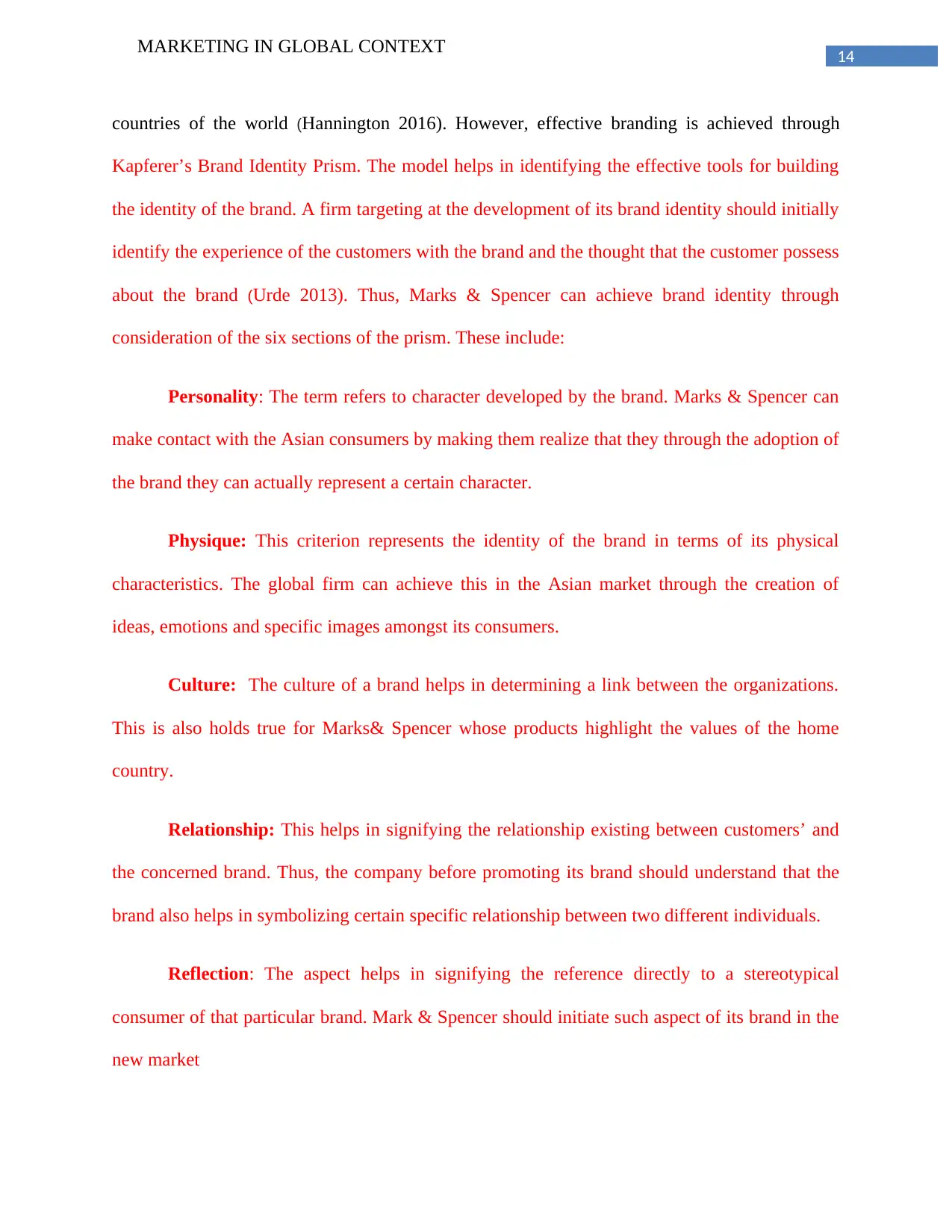
14
MARKETING IN GLOBAL CONTEXT
countries of the world (Hannington 2016). However, effective branding is achieved through
Kapferer’s Brand Identity Prism. The model helps in identifying the effective tools for building
the identity of the brand. A firm targeting at the development of its brand identity should initially
identify the experience of the customers with the brand and the thought that the customer possess
about the brand (Urde 2013). Thus, Marks & Spencer can achieve brand identity through
consideration of the six sections of the prism. These include:
Personality: The term refers to character developed by the brand. Marks & Spencer can
make contact with the Asian consumers by making them realize that they through the adoption of
the brand they can actually represent a certain character.
Physique: This criterion represents the identity of the brand in terms of its physical
characteristics. The global firm can achieve this in the Asian market through the creation of
ideas, emotions and specific images amongst its consumers.
Culture: The culture of a brand helps in determining a link between the organizations.
This is also holds true for Marks& Spencer whose products highlight the values of the home
country.
Relationship: This helps in signifying the relationship existing between customers’ and
the concerned brand. Thus, the company before promoting its brand should understand that the
brand also helps in symbolizing certain specific relationship between two different individuals.
Reflection: The aspect helps in signifying the reference directly to a stereotypical
consumer of that particular brand. Mark & Spencer should initiate such aspect of its brand in the
new market
MARKETING IN GLOBAL CONTEXT
countries of the world (Hannington 2016). However, effective branding is achieved through
Kapferer’s Brand Identity Prism. The model helps in identifying the effective tools for building
the identity of the brand. A firm targeting at the development of its brand identity should initially
identify the experience of the customers with the brand and the thought that the customer possess
about the brand (Urde 2013). Thus, Marks & Spencer can achieve brand identity through
consideration of the six sections of the prism. These include:
Personality: The term refers to character developed by the brand. Marks & Spencer can
make contact with the Asian consumers by making them realize that they through the adoption of
the brand they can actually represent a certain character.
Physique: This criterion represents the identity of the brand in terms of its physical
characteristics. The global firm can achieve this in the Asian market through the creation of
ideas, emotions and specific images amongst its consumers.
Culture: The culture of a brand helps in determining a link between the organizations.
This is also holds true for Marks& Spencer whose products highlight the values of the home
country.
Relationship: This helps in signifying the relationship existing between customers’ and
the concerned brand. Thus, the company before promoting its brand should understand that the
brand also helps in symbolizing certain specific relationship between two different individuals.
Reflection: The aspect helps in signifying the reference directly to a stereotypical
consumer of that particular brand. Mark & Spencer should initiate such aspect of its brand in the
new market
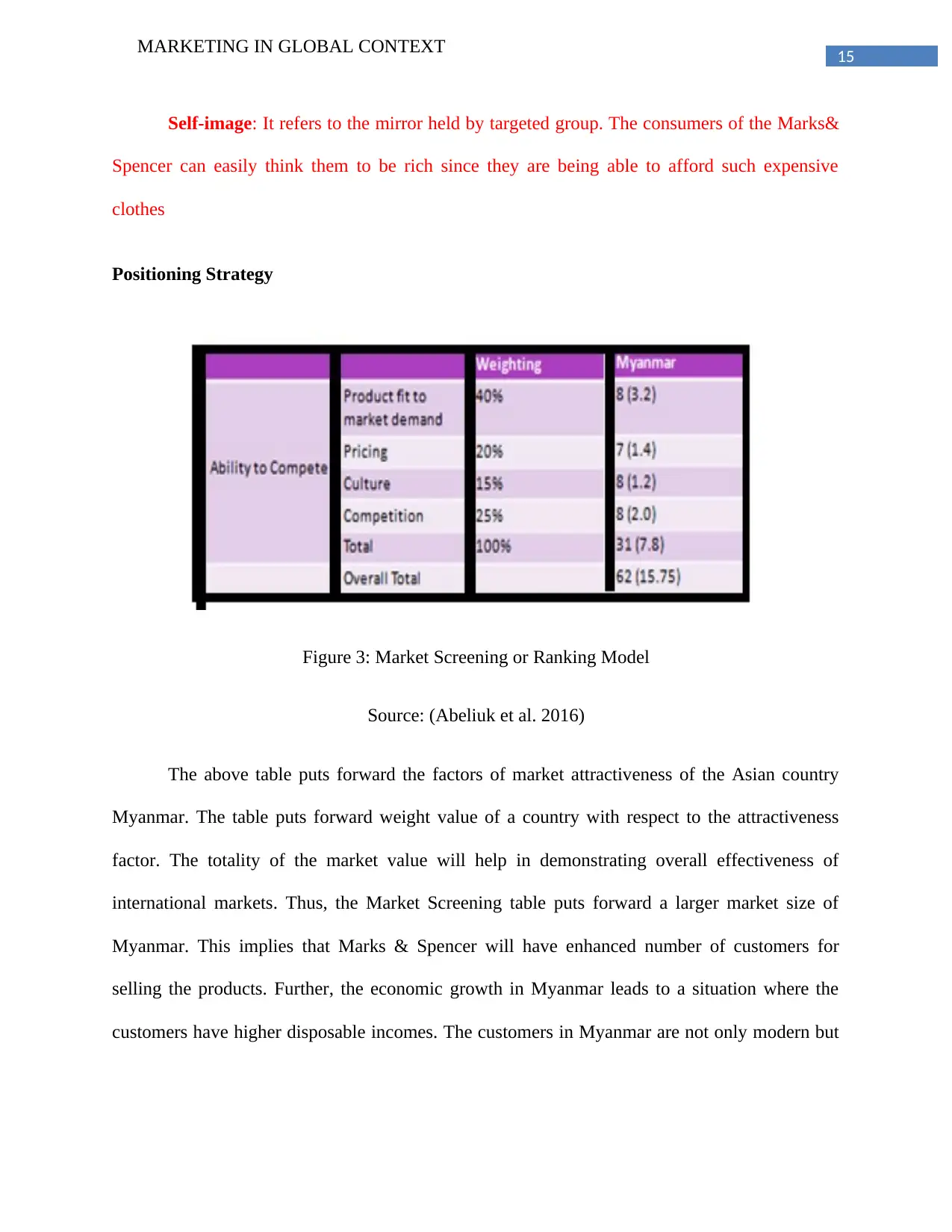
15
MARKETING IN GLOBAL CONTEXT
Self-image: It refers to the mirror held by targeted group. The consumers of the Marks&
Spencer can easily think them to be rich since they are being able to afford such expensive
clothes
Positioning Strategy
Figure 3: Market Screening or Ranking Model
Source: (Abeliuk et al. 2016)
The above table puts forward the factors of market attractiveness of the Asian country
Myanmar. The table puts forward weight value of a country with respect to the attractiveness
factor. The totality of the market value will help in demonstrating overall effectiveness of
international markets. Thus, the Market Screening table puts forward a larger market size of
Myanmar. This implies that Marks & Spencer will have enhanced number of customers for
selling the products. Further, the economic growth in Myanmar leads to a situation where the
customers have higher disposable incomes. The customers in Myanmar are not only modern but
MARKETING IN GLOBAL CONTEXT
Self-image: It refers to the mirror held by targeted group. The consumers of the Marks&
Spencer can easily think them to be rich since they are being able to afford such expensive
clothes
Positioning Strategy
Figure 3: Market Screening or Ranking Model
Source: (Abeliuk et al. 2016)
The above table puts forward the factors of market attractiveness of the Asian country
Myanmar. The table puts forward weight value of a country with respect to the attractiveness
factor. The totality of the market value will help in demonstrating overall effectiveness of
international markets. Thus, the Market Screening table puts forward a larger market size of
Myanmar. This implies that Marks & Spencer will have enhanced number of customers for
selling the products. Further, the economic growth in Myanmar leads to a situation where the
customers have higher disposable incomes. The customers in Myanmar are not only modern but
Secure Best Marks with AI Grader
Need help grading? Try our AI Grader for instant feedback on your assignments.
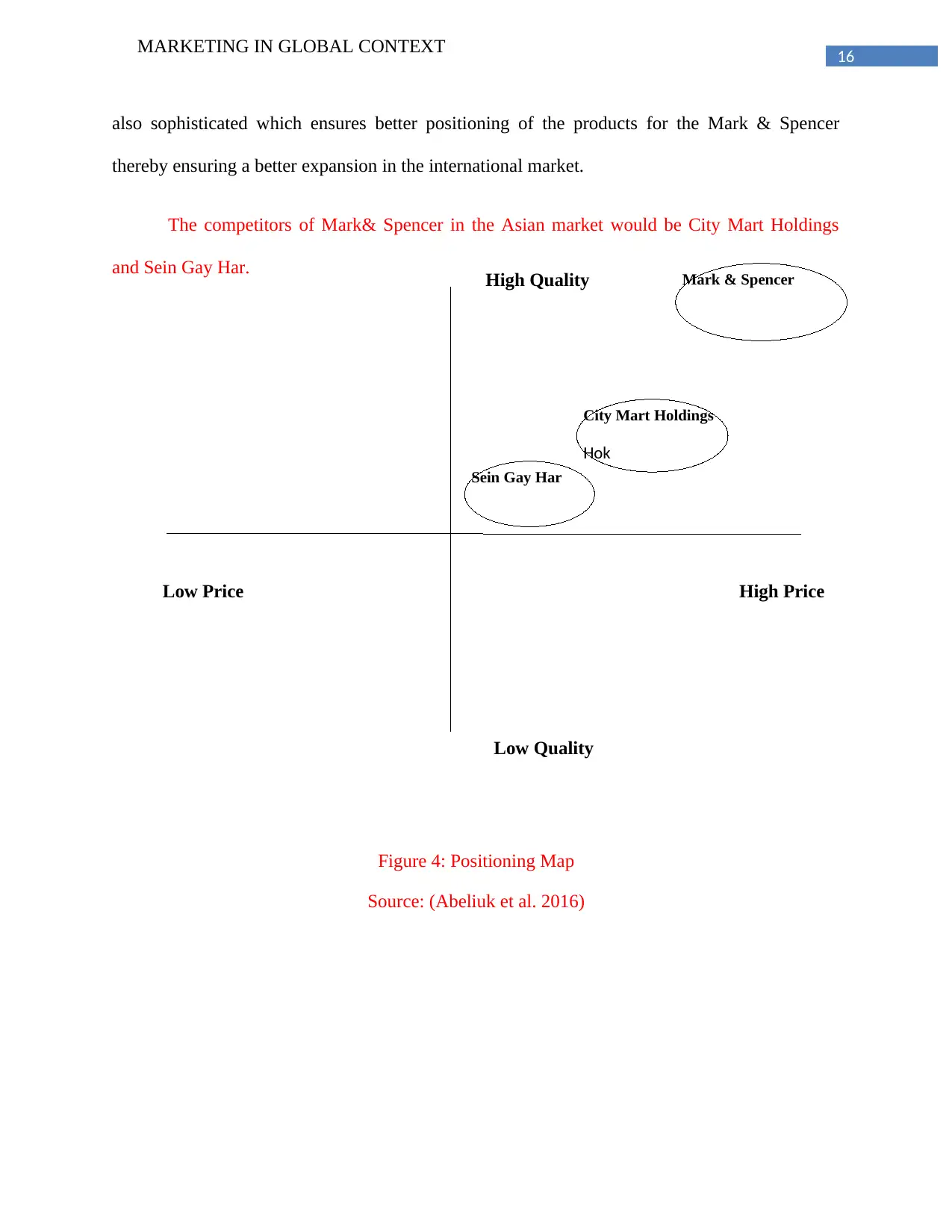
16
MARKETING IN GLOBAL CONTEXT
also sophisticated which ensures better positioning of the products for the Mark & Spencer
thereby ensuring a better expansion in the international market.
The competitors of Mark& Spencer in the Asian market would be City Mart Holdings
and Sein Gay Har.
Figure 4: Positioning Map
Source: (Abeliuk et al. 2016)
High PriceLow Price
High Quality
Low Quality
Sein Gay Har
City Mart Holdings
Hok
Mark & Spencer
MARKETING IN GLOBAL CONTEXT
also sophisticated which ensures better positioning of the products for the Mark & Spencer
thereby ensuring a better expansion in the international market.
The competitors of Mark& Spencer in the Asian market would be City Mart Holdings
and Sein Gay Har.
Figure 4: Positioning Map
Source: (Abeliuk et al. 2016)
High PriceLow Price
High Quality
Low Quality
Sein Gay Har
City Mart Holdings
Hok
Mark & Spencer
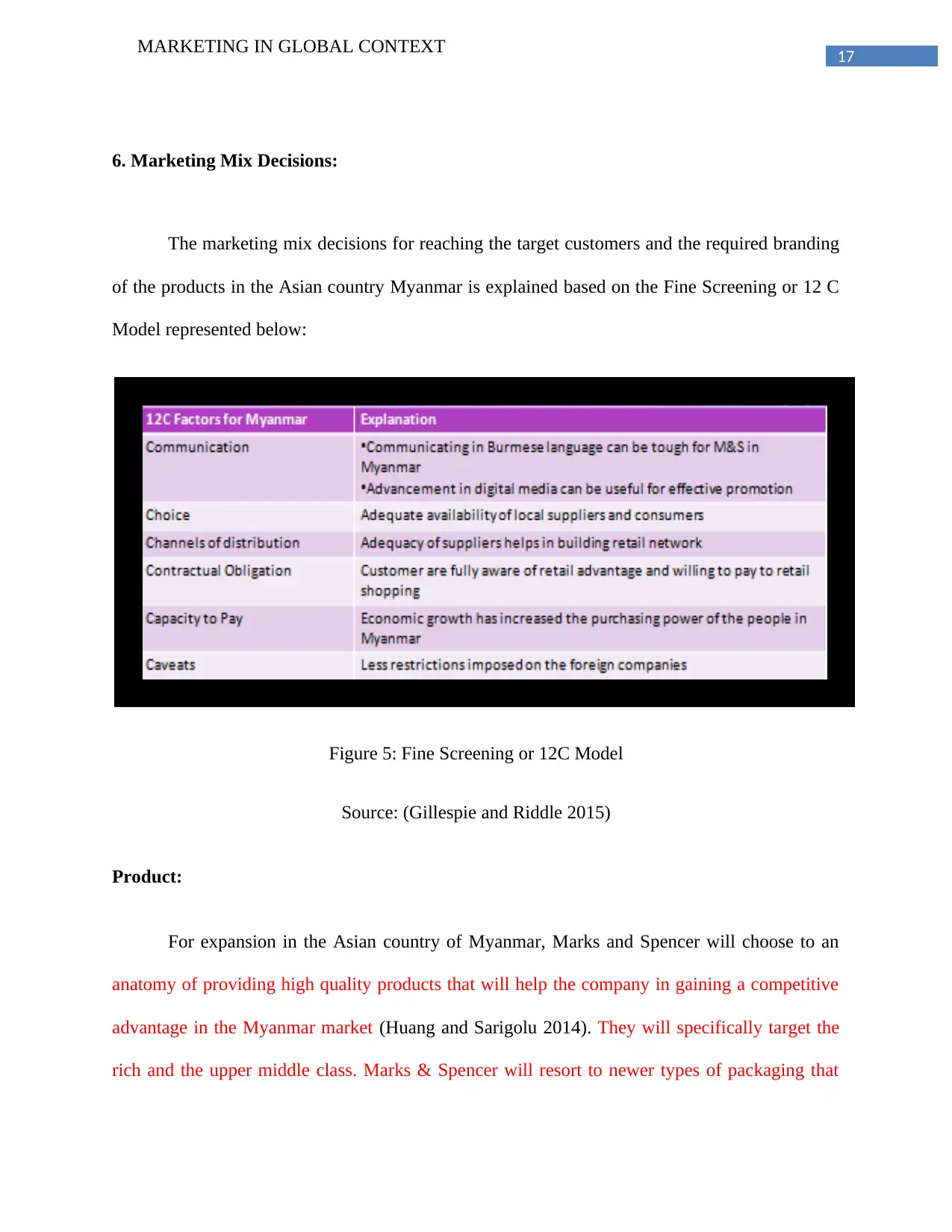
17
MARKETING IN GLOBAL CONTEXT
6. Marketing Mix Decisions:
The marketing mix decisions for reaching the target customers and the required branding
of the products in the Asian country Myanmar is explained based on the Fine Screening or 12 C
Model represented below:
Figure 5: Fine Screening or 12C Model
Source: (Gillespie and Riddle 2015)
Product:
For expansion in the Asian country of Myanmar, Marks and Spencer will choose to an
anatomy of providing high quality products that will help the company in gaining a competitive
advantage in the Myanmar market (Huang and Sarigolu 2014). They will specifically target the
rich and the upper middle class. Marks & Spencer will resort to newer types of packaging that
MARKETING IN GLOBAL CONTEXT
6. Marketing Mix Decisions:
The marketing mix decisions for reaching the target customers and the required branding
of the products in the Asian country Myanmar is explained based on the Fine Screening or 12 C
Model represented below:
Figure 5: Fine Screening or 12C Model
Source: (Gillespie and Riddle 2015)
Product:
For expansion in the Asian country of Myanmar, Marks and Spencer will choose to an
anatomy of providing high quality products that will help the company in gaining a competitive
advantage in the Myanmar market (Huang and Sarigolu 2014). They will specifically target the
rich and the upper middle class. Marks & Spencer will resort to newer types of packaging that
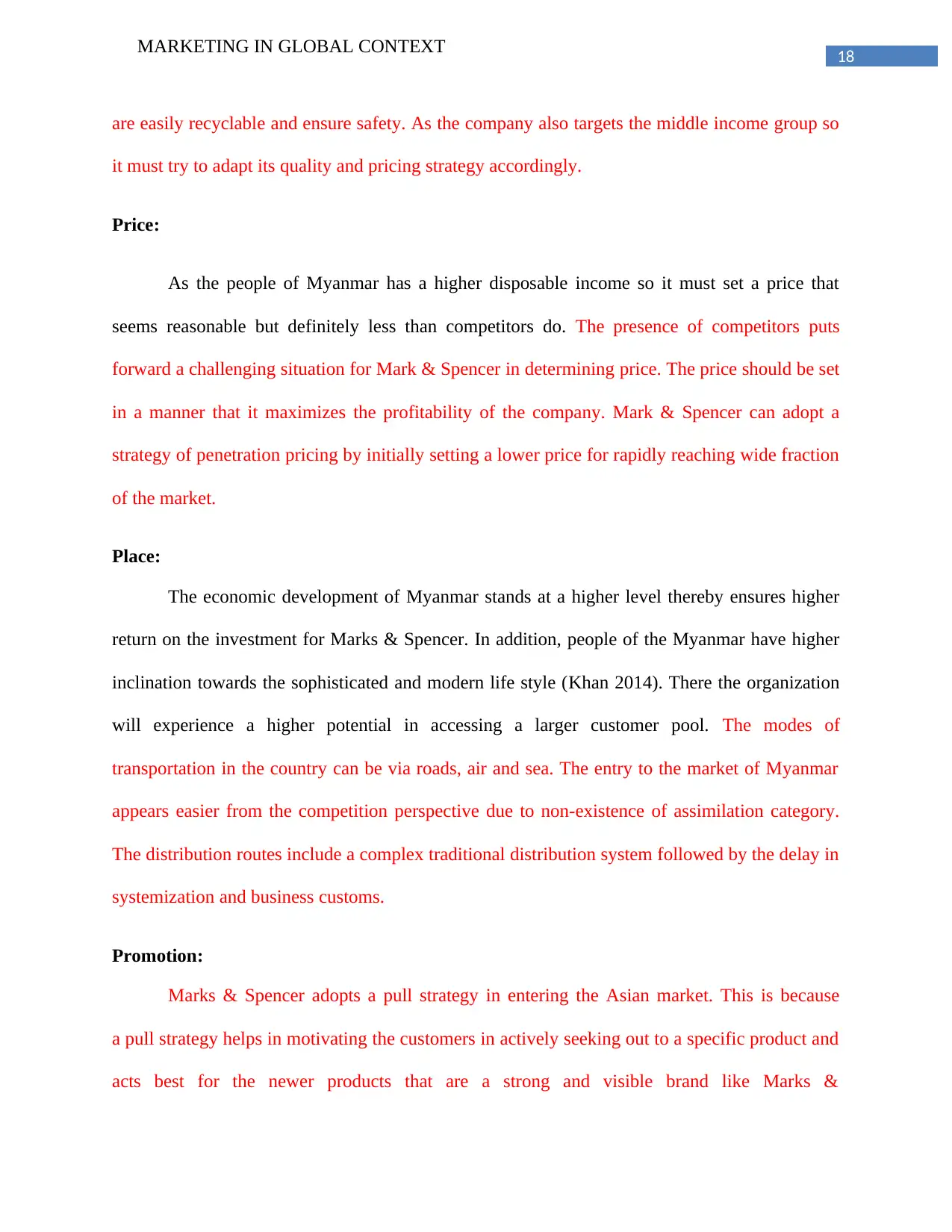
18
MARKETING IN GLOBAL CONTEXT
are easily recyclable and ensure safety. As the company also targets the middle income group so
it must try to adapt its quality and pricing strategy accordingly.
Price:
As the people of Myanmar has a higher disposable income so it must set a price that
seems reasonable but definitely less than competitors do. The presence of competitors puts
forward a challenging situation for Mark & Spencer in determining price. The price should be set
in a manner that it maximizes the profitability of the company. Mark & Spencer can adopt a
strategy of penetration pricing by initially setting a lower price for rapidly reaching wide fraction
of the market.
Place:
The economic development of Myanmar stands at a higher level thereby ensures higher
return on the investment for Marks & Spencer. In addition, people of the Myanmar have higher
inclination towards the sophisticated and modern life style (Khan 2014). There the organization
will experience a higher potential in accessing a larger customer pool. The modes of
transportation in the country can be via roads, air and sea. The entry to the market of Myanmar
appears easier from the competition perspective due to non-existence of assimilation category.
The distribution routes include a complex traditional distribution system followed by the delay in
systemization and business customs.
Promotion:
Marks & Spencer adopts a pull strategy in entering the Asian market. This is because
a pull strategy helps in motivating the customers in actively seeking out to a specific product and
acts best for the newer products that are a strong and visible brand like Marks &
MARKETING IN GLOBAL CONTEXT
are easily recyclable and ensure safety. As the company also targets the middle income group so
it must try to adapt its quality and pricing strategy accordingly.
Price:
As the people of Myanmar has a higher disposable income so it must set a price that
seems reasonable but definitely less than competitors do. The presence of competitors puts
forward a challenging situation for Mark & Spencer in determining price. The price should be set
in a manner that it maximizes the profitability of the company. Mark & Spencer can adopt a
strategy of penetration pricing by initially setting a lower price for rapidly reaching wide fraction
of the market.
Place:
The economic development of Myanmar stands at a higher level thereby ensures higher
return on the investment for Marks & Spencer. In addition, people of the Myanmar have higher
inclination towards the sophisticated and modern life style (Khan 2014). There the organization
will experience a higher potential in accessing a larger customer pool. The modes of
transportation in the country can be via roads, air and sea. The entry to the market of Myanmar
appears easier from the competition perspective due to non-existence of assimilation category.
The distribution routes include a complex traditional distribution system followed by the delay in
systemization and business customs.
Promotion:
Marks & Spencer adopts a pull strategy in entering the Asian market. This is because
a pull strategy helps in motivating the customers in actively seeking out to a specific product and
acts best for the newer products that are a strong and visible brand like Marks &
Paraphrase This Document
Need a fresh take? Get an instant paraphrase of this document with our AI Paraphraser
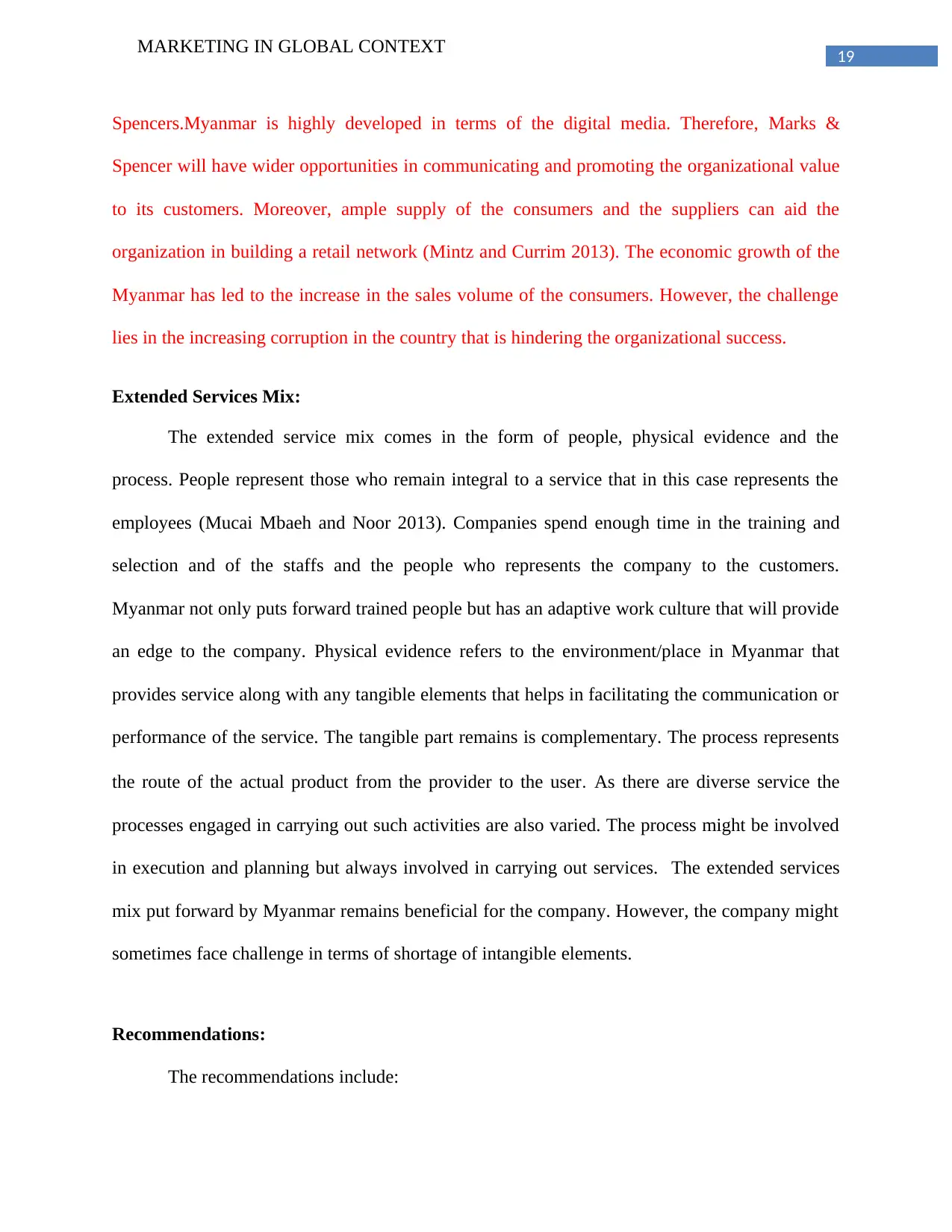
19
MARKETING IN GLOBAL CONTEXT
Spencers.Myanmar is highly developed in terms of the digital media. Therefore, Marks &
Spencer will have wider opportunities in communicating and promoting the organizational value
to its customers. Moreover, ample supply of the consumers and the suppliers can aid the
organization in building a retail network (Mintz and Currim 2013). The economic growth of the
Myanmar has led to the increase in the sales volume of the consumers. However, the challenge
lies in the increasing corruption in the country that is hindering the organizational success.
Extended Services Mix:
The extended service mix comes in the form of people, physical evidence and the
process. People represent those who remain integral to a service that in this case represents the
employees (Mucai Mbaeh and Noor 2013). Companies spend enough time in the training and
selection and of the staffs and the people who represents the company to the customers.
Myanmar not only puts forward trained people but has an adaptive work culture that will provide
an edge to the company. Physical evidence refers to the environment/place in Myanmar that
provides service along with any tangible elements that helps in facilitating the communication or
performance of the service. The tangible part remains is complementary. The process represents
the route of the actual product from the provider to the user. As there are diverse service the
processes engaged in carrying out such activities are also varied. The process might be involved
in execution and planning but always involved in carrying out services. The extended services
mix put forward by Myanmar remains beneficial for the company. However, the company might
sometimes face challenge in terms of shortage of intangible elements.
Recommendations:
The recommendations include:
MARKETING IN GLOBAL CONTEXT
Spencers.Myanmar is highly developed in terms of the digital media. Therefore, Marks &
Spencer will have wider opportunities in communicating and promoting the organizational value
to its customers. Moreover, ample supply of the consumers and the suppliers can aid the
organization in building a retail network (Mintz and Currim 2013). The economic growth of the
Myanmar has led to the increase in the sales volume of the consumers. However, the challenge
lies in the increasing corruption in the country that is hindering the organizational success.
Extended Services Mix:
The extended service mix comes in the form of people, physical evidence and the
process. People represent those who remain integral to a service that in this case represents the
employees (Mucai Mbaeh and Noor 2013). Companies spend enough time in the training and
selection and of the staffs and the people who represents the company to the customers.
Myanmar not only puts forward trained people but has an adaptive work culture that will provide
an edge to the company. Physical evidence refers to the environment/place in Myanmar that
provides service along with any tangible elements that helps in facilitating the communication or
performance of the service. The tangible part remains is complementary. The process represents
the route of the actual product from the provider to the user. As there are diverse service the
processes engaged in carrying out such activities are also varied. The process might be involved
in execution and planning but always involved in carrying out services. The extended services
mix put forward by Myanmar remains beneficial for the company. However, the company might
sometimes face challenge in terms of shortage of intangible elements.
Recommendations:
The recommendations include:
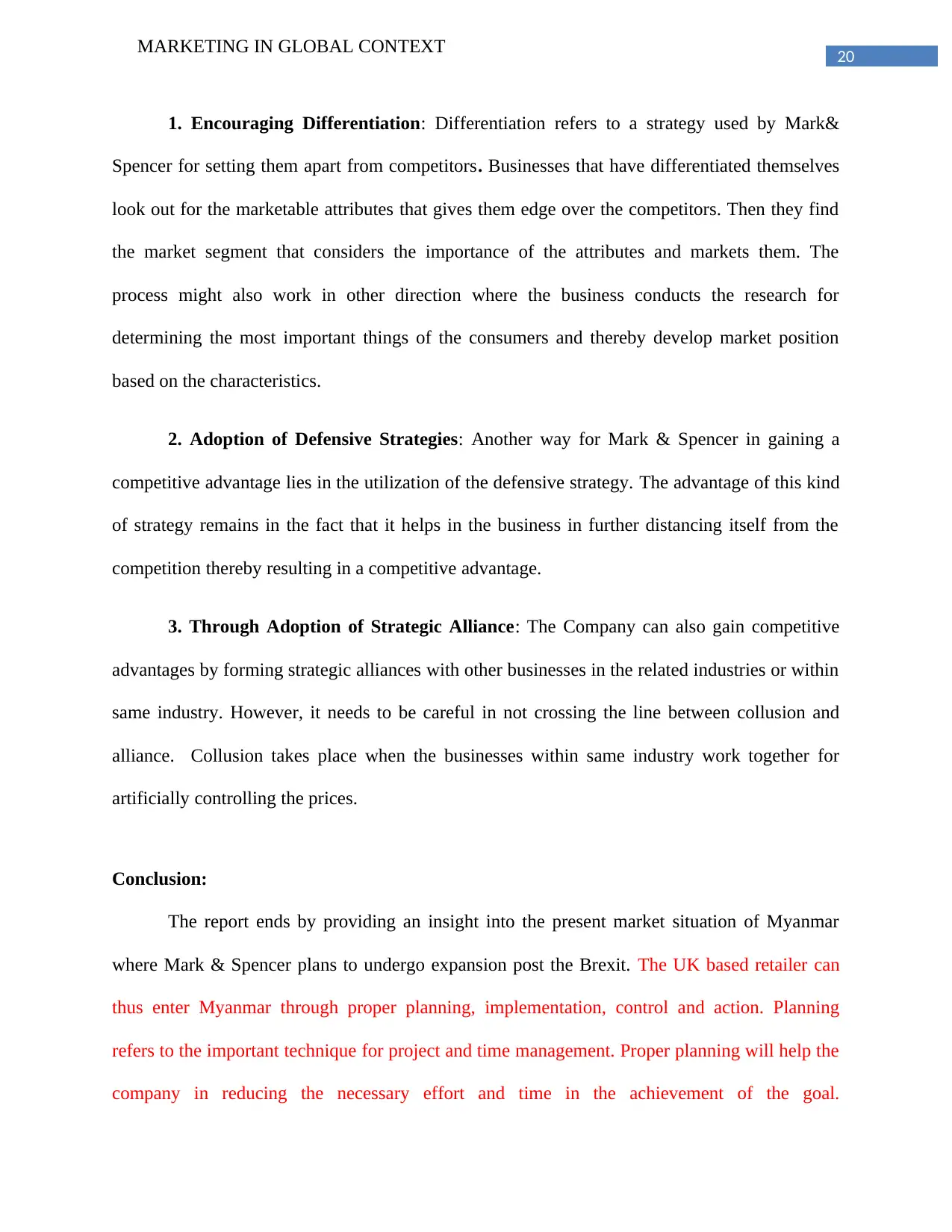
20
MARKETING IN GLOBAL CONTEXT
1. Encouraging Differentiation: Differentiation refers to a strategy used by Mark&
Spencer for setting them apart from competitors. Businesses that have differentiated themselves
look out for the marketable attributes that gives them edge over the competitors. Then they find
the market segment that considers the importance of the attributes and markets them. The
process might also work in other direction where the business conducts the research for
determining the most important things of the consumers and thereby develop market position
based on the characteristics.
2. Adoption of Defensive Strategies: Another way for Mark & Spencer in gaining a
competitive advantage lies in the utilization of the defensive strategy. The advantage of this kind
of strategy remains in the fact that it helps in the business in further distancing itself from the
competition thereby resulting in a competitive advantage.
3. Through Adoption of Strategic Alliance: The Company can also gain competitive
advantages by forming strategic alliances with other businesses in the related industries or within
same industry. However, it needs to be careful in not crossing the line between collusion and
alliance. Collusion takes place when the businesses within same industry work together for
artificially controlling the prices.
Conclusion:
The report ends by providing an insight into the present market situation of Myanmar
where Mark & Spencer plans to undergo expansion post the Brexit. The UK based retailer can
thus enter Myanmar through proper planning, implementation, control and action. Planning
refers to the important technique for project and time management. Proper planning will help the
company in reducing the necessary effort and time in the achievement of the goal.
MARKETING IN GLOBAL CONTEXT
1. Encouraging Differentiation: Differentiation refers to a strategy used by Mark&
Spencer for setting them apart from competitors. Businesses that have differentiated themselves
look out for the marketable attributes that gives them edge over the competitors. Then they find
the market segment that considers the importance of the attributes and markets them. The
process might also work in other direction where the business conducts the research for
determining the most important things of the consumers and thereby develop market position
based on the characteristics.
2. Adoption of Defensive Strategies: Another way for Mark & Spencer in gaining a
competitive advantage lies in the utilization of the defensive strategy. The advantage of this kind
of strategy remains in the fact that it helps in the business in further distancing itself from the
competition thereby resulting in a competitive advantage.
3. Through Adoption of Strategic Alliance: The Company can also gain competitive
advantages by forming strategic alliances with other businesses in the related industries or within
same industry. However, it needs to be careful in not crossing the line between collusion and
alliance. Collusion takes place when the businesses within same industry work together for
artificially controlling the prices.
Conclusion:
The report ends by providing an insight into the present market situation of Myanmar
where Mark & Spencer plans to undergo expansion post the Brexit. The UK based retailer can
thus enter Myanmar through proper planning, implementation, control and action. Planning
refers to the important technique for project and time management. Proper planning will help the
company in reducing the necessary effort and time in the achievement of the goal.
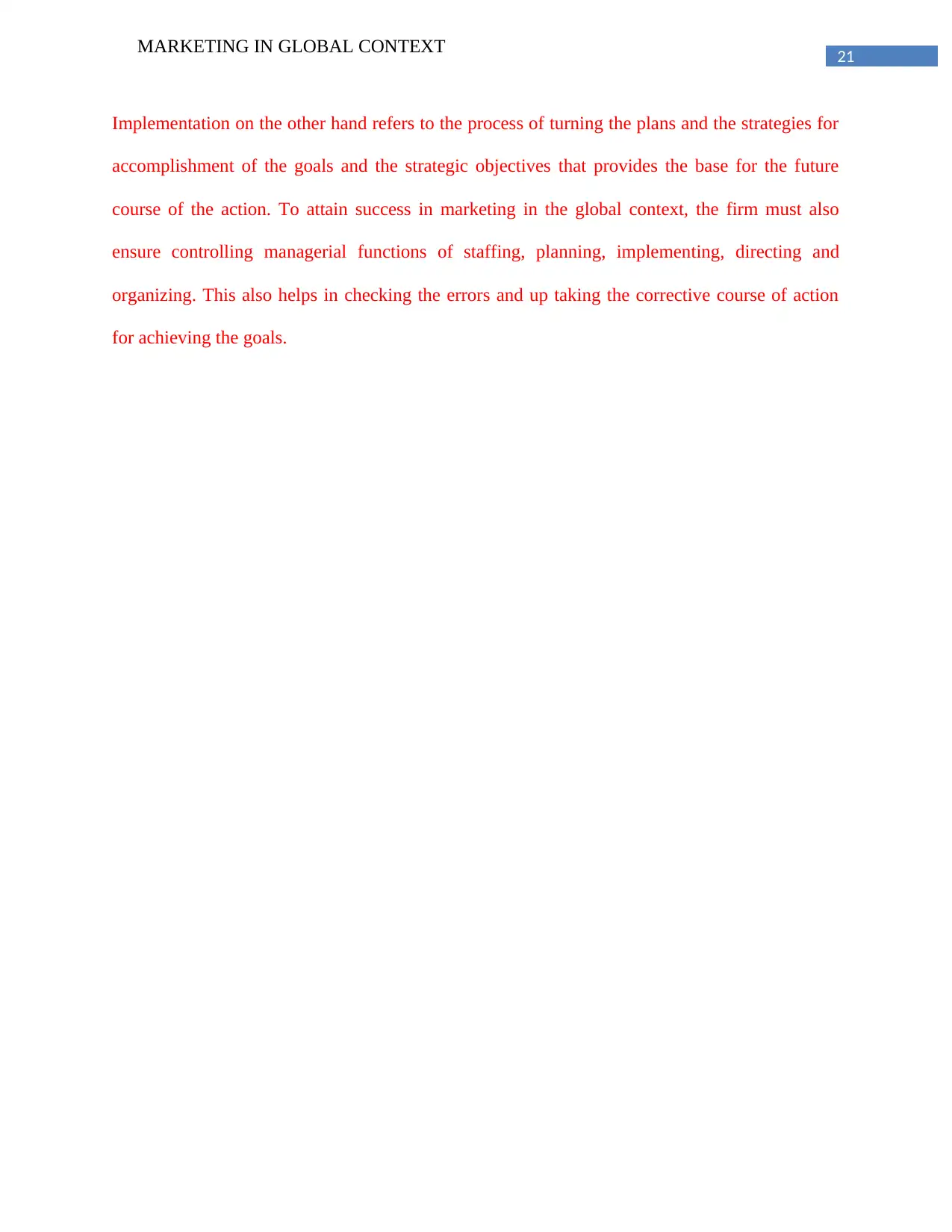
21
MARKETING IN GLOBAL CONTEXT
Implementation on the other hand refers to the process of turning the plans and the strategies for
accomplishment of the goals and the strategic objectives that provides the base for the future
course of the action. To attain success in marketing in the global context, the firm must also
ensure controlling managerial functions of staffing, planning, implementing, directing and
organizing. This also helps in checking the errors and up taking the corrective course of action
for achieving the goals.
MARKETING IN GLOBAL CONTEXT
Implementation on the other hand refers to the process of turning the plans and the strategies for
accomplishment of the goals and the strategic objectives that provides the base for the future
course of the action. To attain success in marketing in the global context, the firm must also
ensure controlling managerial functions of staffing, planning, implementing, directing and
organizing. This also helps in checking the errors and up taking the corrective course of action
for achieving the goals.
Secure Best Marks with AI Grader
Need help grading? Try our AI Grader for instant feedback on your assignments.
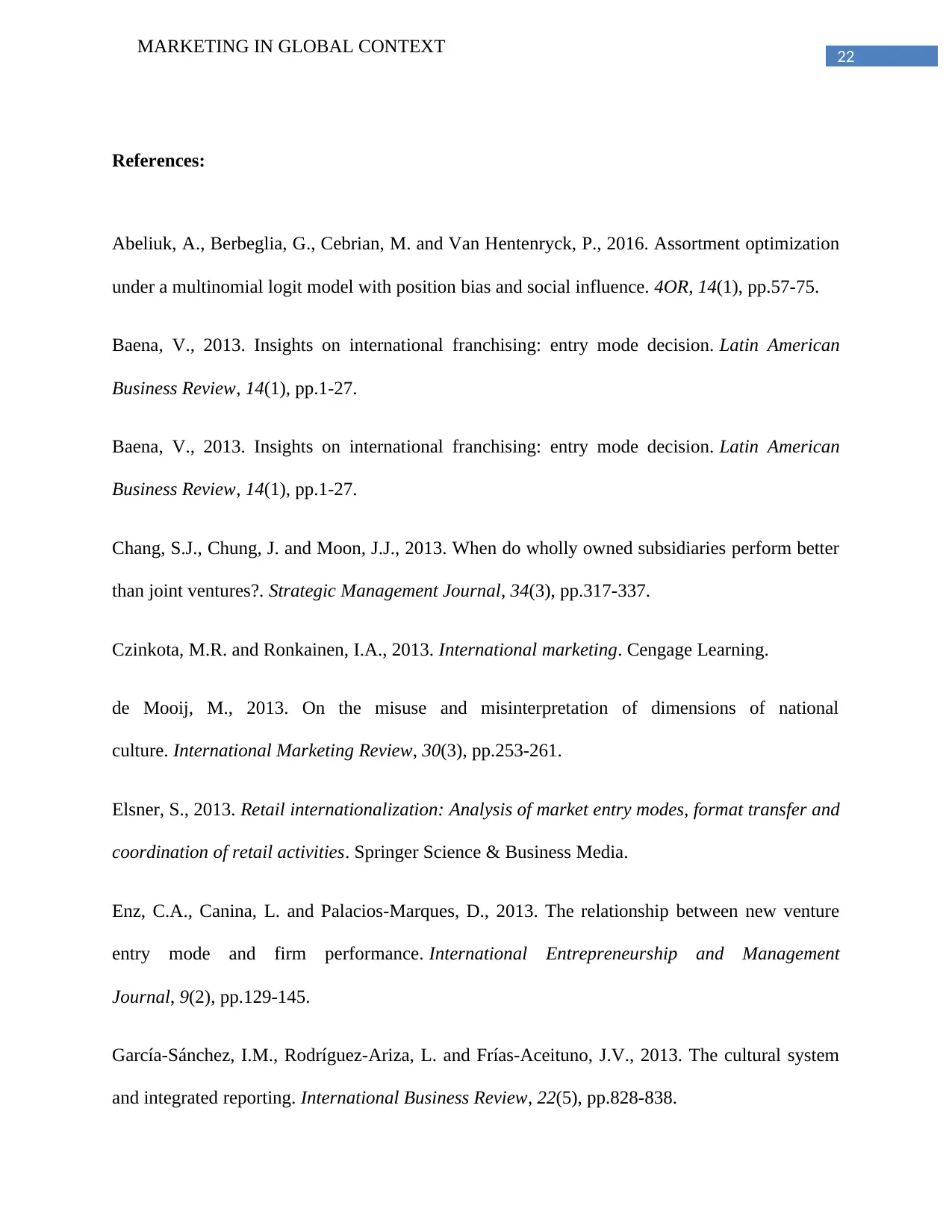
22
MARKETING IN GLOBAL CONTEXT
References:
Abeliuk, A., Berbeglia, G., Cebrian, M. and Van Hentenryck, P., 2016. Assortment optimization
under a multinomial logit model with position bias and social influence. 4OR, 14(1), pp.57-75.
Baena, V., 2013. Insights on international franchising: entry mode decision. Latin American
Business Review, 14(1), pp.1-27.
Baena, V., 2013. Insights on international franchising: entry mode decision. Latin American
Business Review, 14(1), pp.1-27.
Chang, S.J., Chung, J. and Moon, J.J., 2013. When do wholly owned subsidiaries perform better
than joint ventures?. Strategic Management Journal, 34(3), pp.317-337.
Czinkota, M.R. and Ronkainen, I.A., 2013. International marketing. Cengage Learning.
de Mooij, M., 2013. On the misuse and misinterpretation of dimensions of national
culture. International Marketing Review, 30(3), pp.253-261.
Elsner, S., 2013. Retail internationalization: Analysis of market entry modes, format transfer and
coordination of retail activities. Springer Science & Business Media.
Enz, C.A., Canina, L. and Palacios-Marques, D., 2013. The relationship between new venture
entry mode and firm performance. International Entrepreneurship and Management
Journal, 9(2), pp.129-145.
García-Sánchez, I.M., Rodríguez-Ariza, L. and Frías-Aceituno, J.V., 2013. The cultural system
and integrated reporting. International Business Review, 22(5), pp.828-838.
MARKETING IN GLOBAL CONTEXT
References:
Abeliuk, A., Berbeglia, G., Cebrian, M. and Van Hentenryck, P., 2016. Assortment optimization
under a multinomial logit model with position bias and social influence. 4OR, 14(1), pp.57-75.
Baena, V., 2013. Insights on international franchising: entry mode decision. Latin American
Business Review, 14(1), pp.1-27.
Baena, V., 2013. Insights on international franchising: entry mode decision. Latin American
Business Review, 14(1), pp.1-27.
Chang, S.J., Chung, J. and Moon, J.J., 2013. When do wholly owned subsidiaries perform better
than joint ventures?. Strategic Management Journal, 34(3), pp.317-337.
Czinkota, M.R. and Ronkainen, I.A., 2013. International marketing. Cengage Learning.
de Mooij, M., 2013. On the misuse and misinterpretation of dimensions of national
culture. International Marketing Review, 30(3), pp.253-261.
Elsner, S., 2013. Retail internationalization: Analysis of market entry modes, format transfer and
coordination of retail activities. Springer Science & Business Media.
Enz, C.A., Canina, L. and Palacios-Marques, D., 2013. The relationship between new venture
entry mode and firm performance. International Entrepreneurship and Management
Journal, 9(2), pp.129-145.
García-Sánchez, I.M., Rodríguez-Ariza, L. and Frías-Aceituno, J.V., 2013. The cultural system
and integrated reporting. International Business Review, 22(5), pp.828-838.
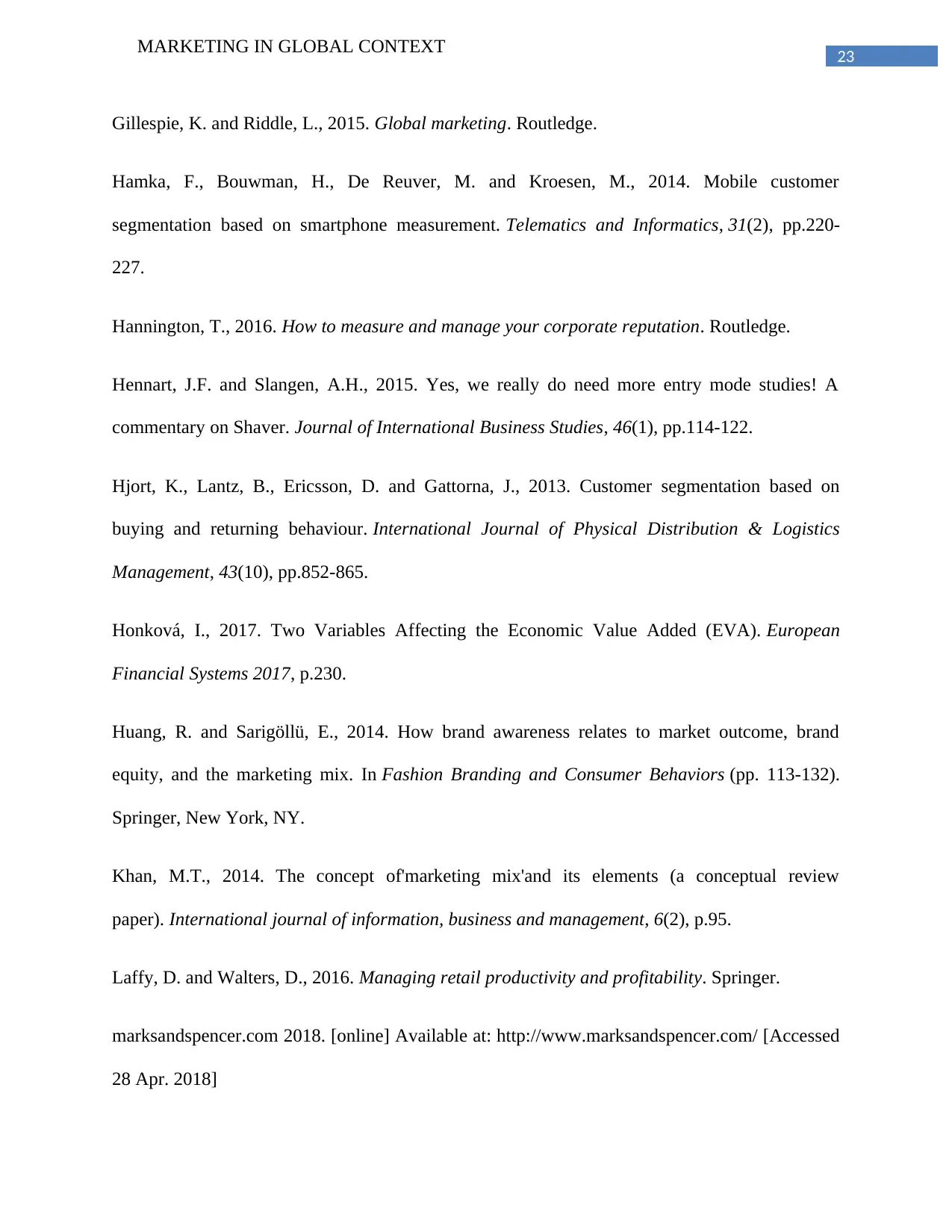
23
MARKETING IN GLOBAL CONTEXT
Gillespie, K. and Riddle, L., 2015. Global marketing. Routledge.
Hamka, F., Bouwman, H., De Reuver, M. and Kroesen, M., 2014. Mobile customer
segmentation based on smartphone measurement. Telematics and Informatics, 31(2), pp.220-
227.
Hannington, T., 2016. How to measure and manage your corporate reputation. Routledge.
Hennart, J.F. and Slangen, A.H., 2015. Yes, we really do need more entry mode studies! A
commentary on Shaver. Journal of International Business Studies, 46(1), pp.114-122.
Hjort, K., Lantz, B., Ericsson, D. and Gattorna, J., 2013. Customer segmentation based on
buying and returning behaviour. International Journal of Physical Distribution & Logistics
Management, 43(10), pp.852-865.
Honková, I., 2017. Two Variables Affecting the Economic Value Added (EVA). European
Financial Systems 2017, p.230.
Huang, R. and Sarigöllü, E., 2014. How brand awareness relates to market outcome, brand
equity, and the marketing mix. In Fashion Branding and Consumer Behaviors (pp. 113-132).
Springer, New York, NY.
Khan, M.T., 2014. The concept of'marketing mix'and its elements (a conceptual review
paper). International journal of information, business and management, 6(2), p.95.
Laffy, D. and Walters, D., 2016. Managing retail productivity and profitability. Springer.
marksandspencer.com 2018. [online] Available at: http://www.marksandspencer.com/ [Accessed
28 Apr. 2018]
MARKETING IN GLOBAL CONTEXT
Gillespie, K. and Riddle, L., 2015. Global marketing. Routledge.
Hamka, F., Bouwman, H., De Reuver, M. and Kroesen, M., 2014. Mobile customer
segmentation based on smartphone measurement. Telematics and Informatics, 31(2), pp.220-
227.
Hannington, T., 2016. How to measure and manage your corporate reputation. Routledge.
Hennart, J.F. and Slangen, A.H., 2015. Yes, we really do need more entry mode studies! A
commentary on Shaver. Journal of International Business Studies, 46(1), pp.114-122.
Hjort, K., Lantz, B., Ericsson, D. and Gattorna, J., 2013. Customer segmentation based on
buying and returning behaviour. International Journal of Physical Distribution & Logistics
Management, 43(10), pp.852-865.
Honková, I., 2017. Two Variables Affecting the Economic Value Added (EVA). European
Financial Systems 2017, p.230.
Huang, R. and Sarigöllü, E., 2014. How brand awareness relates to market outcome, brand
equity, and the marketing mix. In Fashion Branding and Consumer Behaviors (pp. 113-132).
Springer, New York, NY.
Khan, M.T., 2014. The concept of'marketing mix'and its elements (a conceptual review
paper). International journal of information, business and management, 6(2), p.95.
Laffy, D. and Walters, D., 2016. Managing retail productivity and profitability. Springer.
marksandspencer.com 2018. [online] Available at: http://www.marksandspencer.com/ [Accessed
28 Apr. 2018]
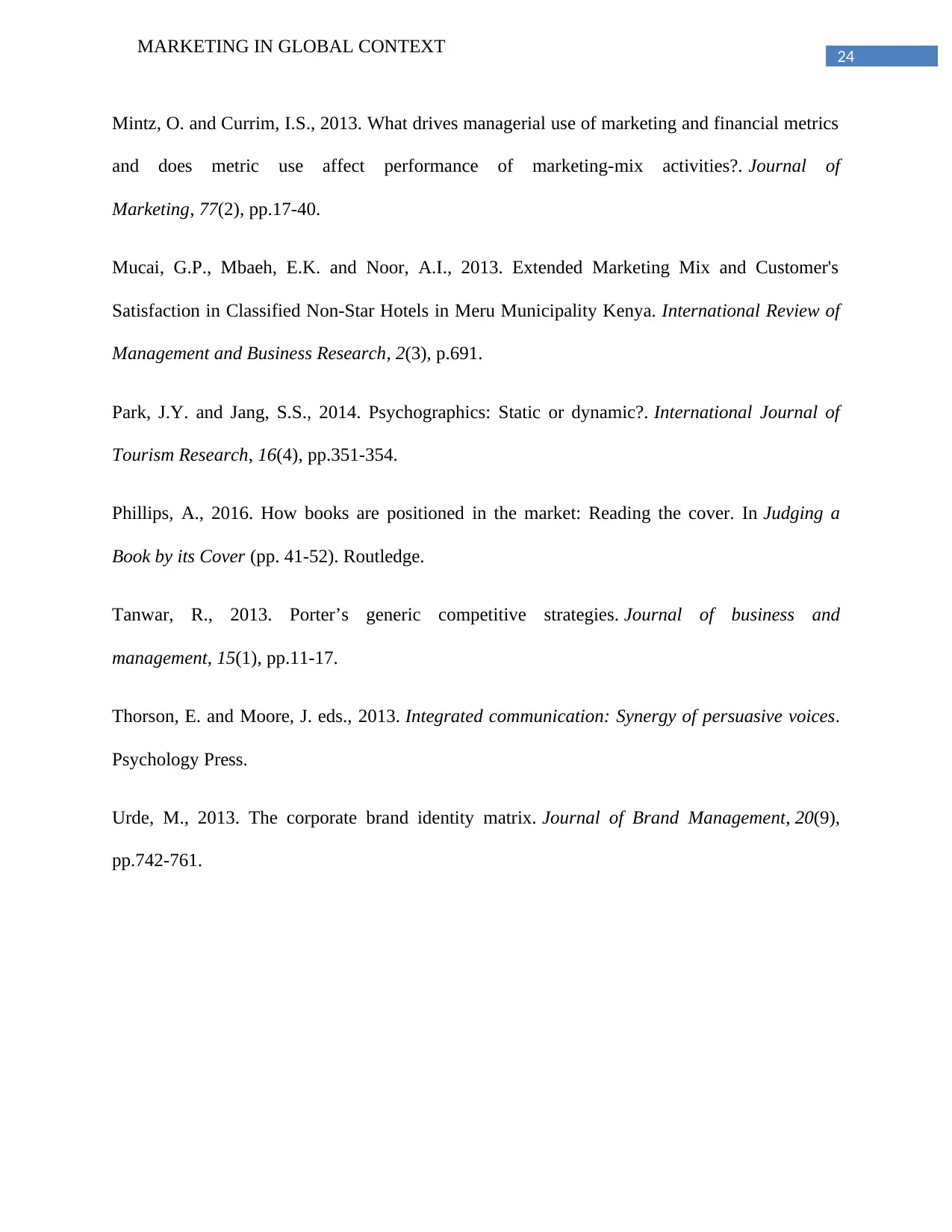
24
MARKETING IN GLOBAL CONTEXT
Mintz, O. and Currim, I.S., 2013. What drives managerial use of marketing and financial metrics
and does metric use affect performance of marketing-mix activities?. Journal of
Marketing, 77(2), pp.17-40.
Mucai, G.P., Mbaeh, E.K. and Noor, A.I., 2013. Extended Marketing Mix and Customer's
Satisfaction in Classified Non-Star Hotels in Meru Municipality Kenya. International Review of
Management and Business Research, 2(3), p.691.
Park, J.Y. and Jang, S.S., 2014. Psychographics: Static or dynamic?. International Journal of
Tourism Research, 16(4), pp.351-354.
Phillips, A., 2016. How books are positioned in the market: Reading the cover. In Judging a
Book by its Cover (pp. 41-52). Routledge.
Tanwar, R., 2013. Porter’s generic competitive strategies. Journal of business and
management, 15(1), pp.11-17.
Thorson, E. and Moore, J. eds., 2013. Integrated communication: Synergy of persuasive voices.
Psychology Press.
Urde, M., 2013. The corporate brand identity matrix. Journal of Brand Management, 20(9),
pp.742-761.
MARKETING IN GLOBAL CONTEXT
Mintz, O. and Currim, I.S., 2013. What drives managerial use of marketing and financial metrics
and does metric use affect performance of marketing-mix activities?. Journal of
Marketing, 77(2), pp.17-40.
Mucai, G.P., Mbaeh, E.K. and Noor, A.I., 2013. Extended Marketing Mix and Customer's
Satisfaction in Classified Non-Star Hotels in Meru Municipality Kenya. International Review of
Management and Business Research, 2(3), p.691.
Park, J.Y. and Jang, S.S., 2014. Psychographics: Static or dynamic?. International Journal of
Tourism Research, 16(4), pp.351-354.
Phillips, A., 2016. How books are positioned in the market: Reading the cover. In Judging a
Book by its Cover (pp. 41-52). Routledge.
Tanwar, R., 2013. Porter’s generic competitive strategies. Journal of business and
management, 15(1), pp.11-17.
Thorson, E. and Moore, J. eds., 2013. Integrated communication: Synergy of persuasive voices.
Psychology Press.
Urde, M., 2013. The corporate brand identity matrix. Journal of Brand Management, 20(9),
pp.742-761.
Paraphrase This Document
Need a fresh take? Get an instant paraphrase of this document with our AI Paraphraser
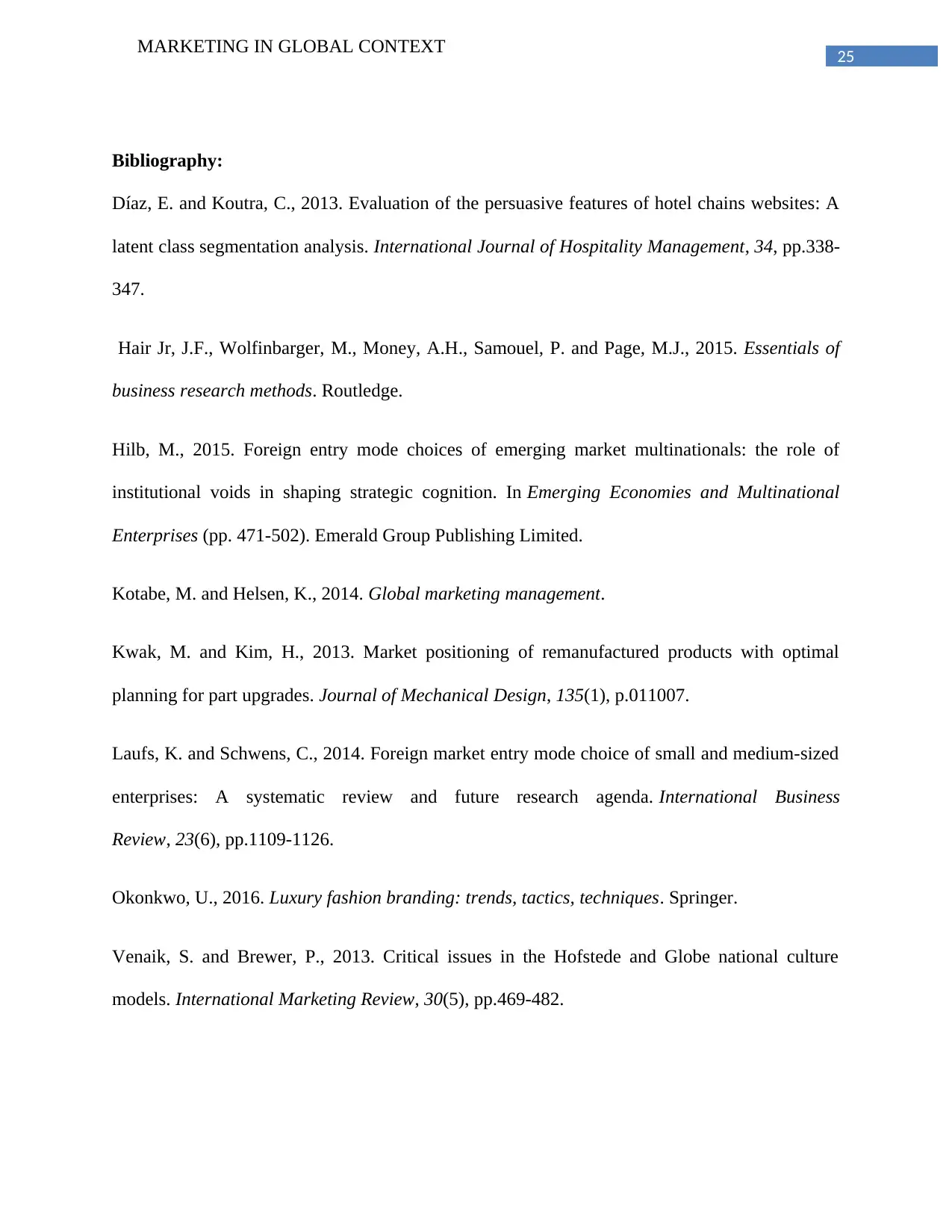
25
MARKETING IN GLOBAL CONTEXT
Bibliography:
Díaz, E. and Koutra, C., 2013. Evaluation of the persuasive features of hotel chains websites: A
latent class segmentation analysis. International Journal of Hospitality Management, 34, pp.338-
347.
Hair Jr, J.F., Wolfinbarger, M., Money, A.H., Samouel, P. and Page, M.J., 2015. Essentials of
business research methods. Routledge.
Hilb, M., 2015. Foreign entry mode choices of emerging market multinationals: the role of
institutional voids in shaping strategic cognition. In Emerging Economies and Multinational
Enterprises (pp. 471-502). Emerald Group Publishing Limited.
Kotabe, M. and Helsen, K., 2014. Global marketing management.
Kwak, M. and Kim, H., 2013. Market positioning of remanufactured products with optimal
planning for part upgrades. Journal of Mechanical Design, 135(1), p.011007.
Laufs, K. and Schwens, C., 2014. Foreign market entry mode choice of small and medium-sized
enterprises: A systematic review and future research agenda. International Business
Review, 23(6), pp.1109-1126.
Okonkwo, U., 2016. Luxury fashion branding: trends, tactics, techniques. Springer.
Venaik, S. and Brewer, P., 2013. Critical issues in the Hofstede and Globe national culture
models. International Marketing Review, 30(5), pp.469-482.
MARKETING IN GLOBAL CONTEXT
Bibliography:
Díaz, E. and Koutra, C., 2013. Evaluation of the persuasive features of hotel chains websites: A
latent class segmentation analysis. International Journal of Hospitality Management, 34, pp.338-
347.
Hair Jr, J.F., Wolfinbarger, M., Money, A.H., Samouel, P. and Page, M.J., 2015. Essentials of
business research methods. Routledge.
Hilb, M., 2015. Foreign entry mode choices of emerging market multinationals: the role of
institutional voids in shaping strategic cognition. In Emerging Economies and Multinational
Enterprises (pp. 471-502). Emerald Group Publishing Limited.
Kotabe, M. and Helsen, K., 2014. Global marketing management.
Kwak, M. and Kim, H., 2013. Market positioning of remanufactured products with optimal
planning for part upgrades. Journal of Mechanical Design, 135(1), p.011007.
Laufs, K. and Schwens, C., 2014. Foreign market entry mode choice of small and medium-sized
enterprises: A systematic review and future research agenda. International Business
Review, 23(6), pp.1109-1126.
Okonkwo, U., 2016. Luxury fashion branding: trends, tactics, techniques. Springer.
Venaik, S. and Brewer, P., 2013. Critical issues in the Hofstede and Globe national culture
models. International Marketing Review, 30(5), pp.469-482.
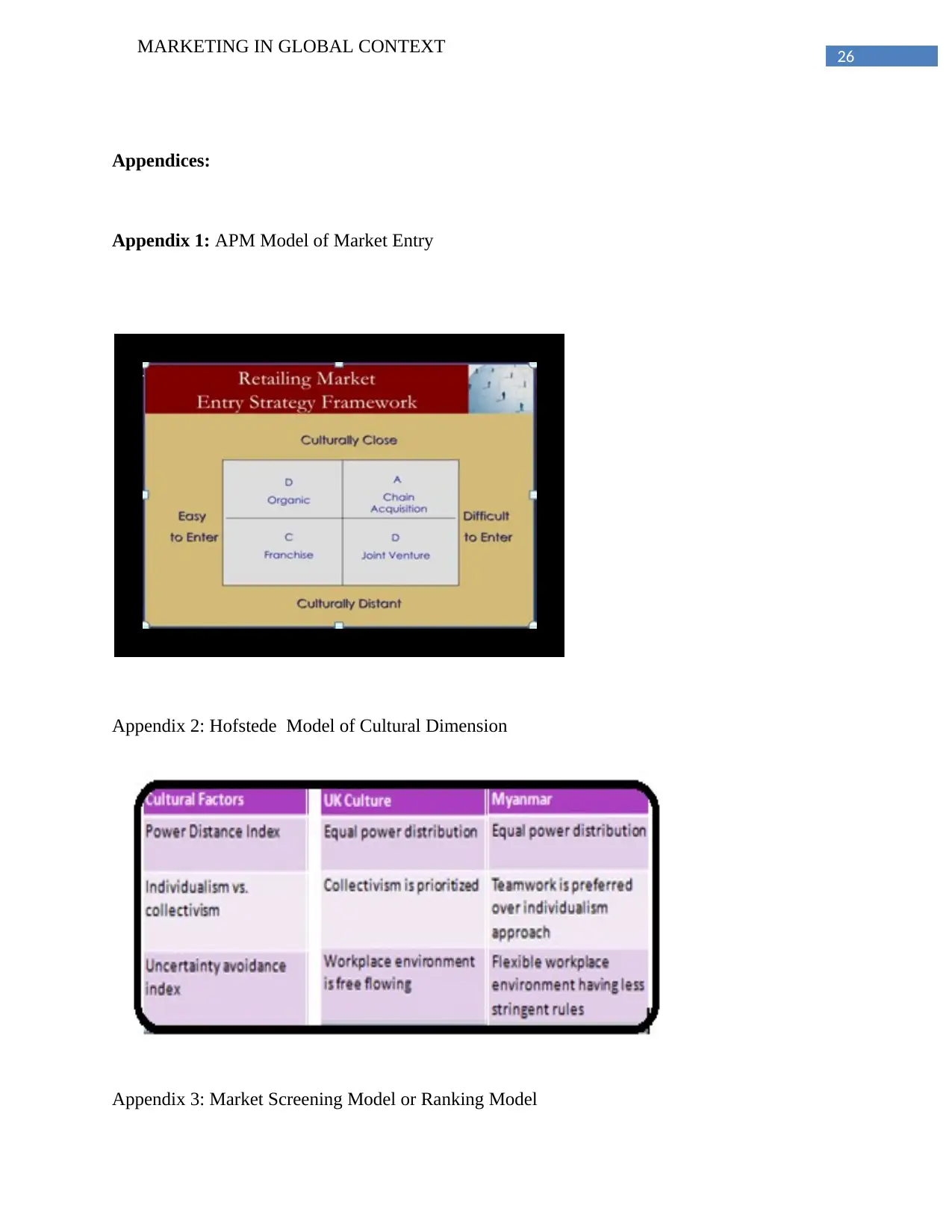
26
MARKETING IN GLOBAL CONTEXT
Appendices:
Appendix 1: APM Model of Market Entry
Appendix 2: Hofstede Model of Cultural Dimension
Appendix 3: Market Screening Model or Ranking Model
MARKETING IN GLOBAL CONTEXT
Appendices:
Appendix 1: APM Model of Market Entry
Appendix 2: Hofstede Model of Cultural Dimension
Appendix 3: Market Screening Model or Ranking Model
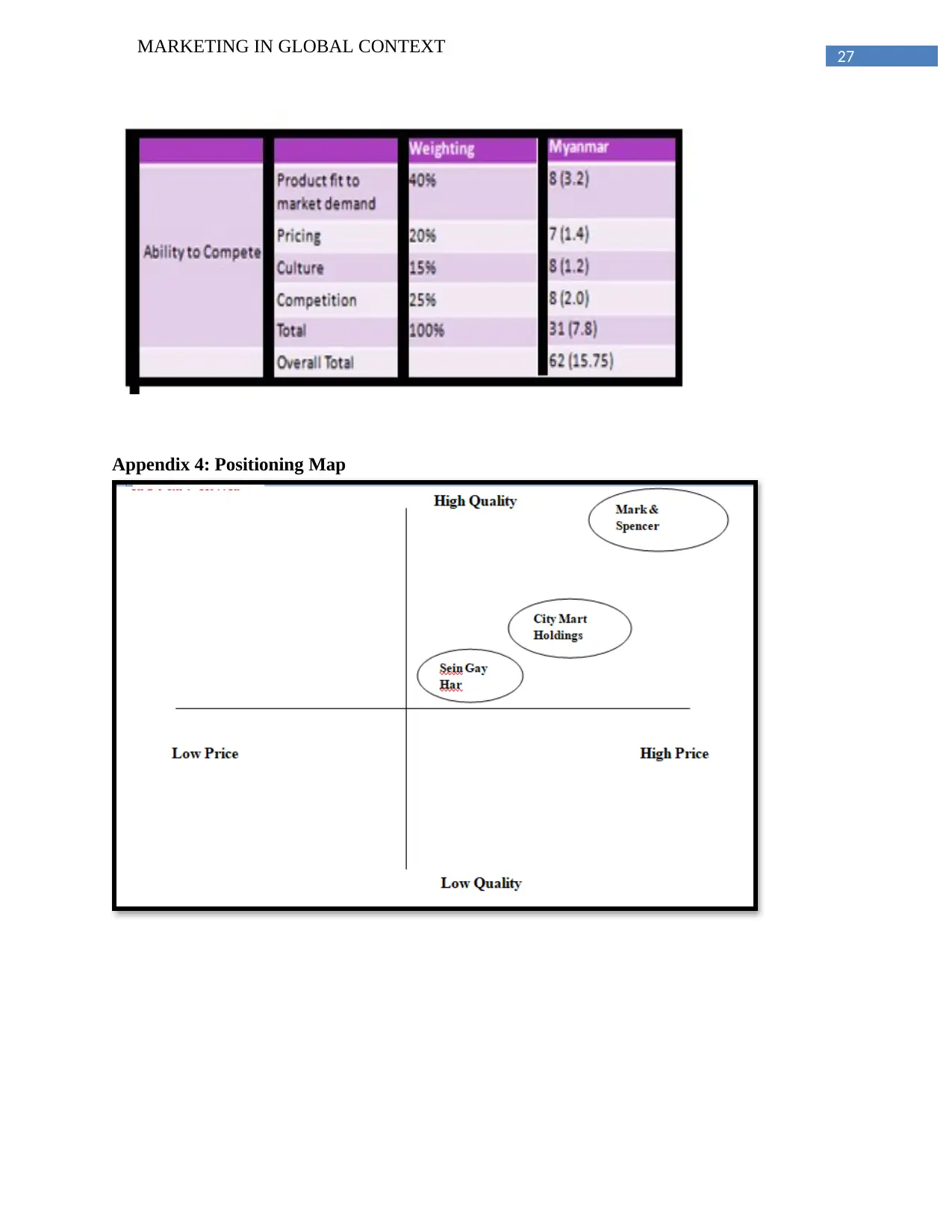
27
MARKETING IN GLOBAL CONTEXT
Appendix 4: Positioning Map
MARKETING IN GLOBAL CONTEXT
Appendix 4: Positioning Map
Secure Best Marks with AI Grader
Need help grading? Try our AI Grader for instant feedback on your assignments.
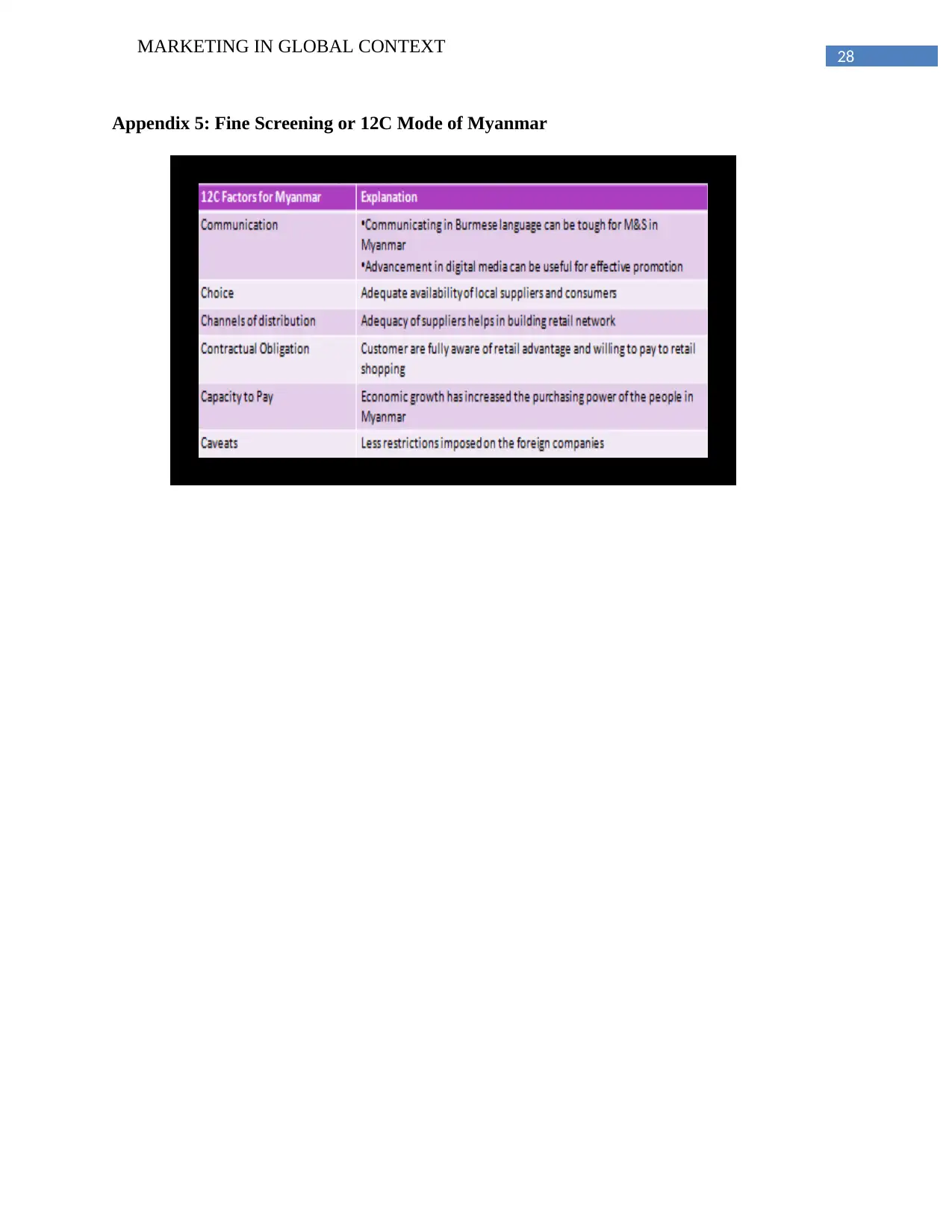
28
MARKETING IN GLOBAL CONTEXT
Appendix 5: Fine Screening or 12C Mode of Myanmar
MARKETING IN GLOBAL CONTEXT
Appendix 5: Fine Screening or 12C Mode of Myanmar
1 out of 29
Related Documents
Your All-in-One AI-Powered Toolkit for Academic Success.
+13062052269
info@desklib.com
Available 24*7 on WhatsApp / Email
![[object Object]](/_next/static/media/star-bottom.7253800d.svg)
Unlock your academic potential
© 2024 | Zucol Services PVT LTD | All rights reserved.





